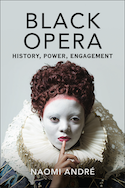May 30, 2018
Feverish love at Opera Holland Park: a fine La traviata opens the 2018 season
Indeed, the lingering damp of the summer storms which had rattled and racketed London throughout the day might have led to fears that the audience might be at risk of joining Violetta behind the black curtain which was laboriously closed during the overture, to enshroud the circular ante-room to the far-right of the stage.
It is a delight to see Gaitanou and her designer Cordelia Chisholm making a virtue rather than an issue of the extensive breadth of the Opera Holland Park stage. Rather than force us to swivel our vision back and forth across the expanse with the agility of a tennis-match crowd - as was the case with Marie Lambert’s scenographically inventive-cum-hyperactive production of Zazà last year - or push the action to a narrow fore-stage strip, as did Oliver Platt last season when directing Don Giovanni , Gaitanou and Chisholm have created a gracious sweep of reflective glass and decorous greenery: a single set which serves equally well as society salon or country chateau. As the strains of the overture unfurl, a footman refreshes the bouquets and un-drapes a chaise-longue. The curtained circle is first boudoir then conservatory; at the close, quasi-brothel then death chamber.
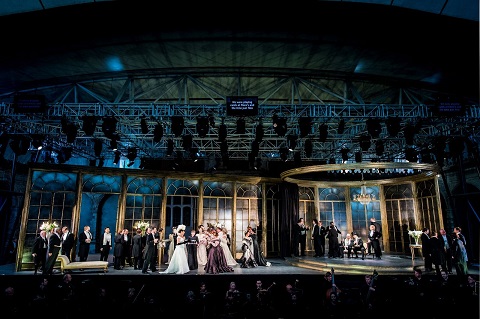 Photo credit: Robert Workman.
Photo credit: Robert Workman.
The lack of scenic fuss sharpens the dramatic clarity and colours are similarly simple and striking. In Act 1 Violetta is helped into a gleaming white gown by her maid Annina, (Ellie Edmonds) the dazzling purity of which sets off the blood-splatters which result from her heart-rending hacking. In the final Act, a black dress signals her doom, while Simon Corder’s garish lighting overwhelms the day-light lucidity with the ghoulish purple excess of Flora’s party. The orangery doors come into their own in this last Act: half-open, they admit both lurid light and tumbling crowds of raucous revellers - the Opera Holland Park Chorus in fine voice.
In the title role, Lauren Fagan proves as adept as Gaitanou and Chisholm at commanding the breadth of the OHP stage. Her soprano has real gloss, her coloratura is shaped with expressive grace and her stage presence is gripping. ‘Sempre libera’ was gleefully carefree, sparkling with agility and diamantine shine. Fagan strides the stage with unwavering composure and even her death-approaching agonies have elegiac elegance.
Many will have been thrilled by Matteo Desole’s ringing and pinging but I found his Alfredo, although technically very assured, to be lacking in emotional resonance. There were a few intonation wobbles at the start - understandable, given that this was the first night in an unfamiliar venue, and things quickly settled - but Desole has only two volume switches, loud and very loud, and despite the bel canto ease, the unalleviated boom was wearisome. This Alfredo seemed emotionally disengaged, an impression exacerbated in Act 2 when he was more interested in rearranging the potted plants in his country conservatory than in living the sentiments of his aria. Despite these misgivings, I can’t deny that Desole’s voice carries effortlessly and his legato phrasing is luxurious - no mean virtues in this venue.
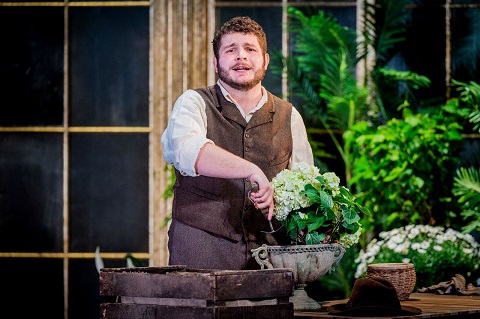 Matteo Desole as Alfredo. Photo credit: Robert Workman.
Matteo Desole as Alfredo. Photo credit: Robert Workman.
Stephen Gadd’s Germont is unbendingly bourgeois and stern, though he clearly comes to recognise Violetta’s courtesy and good manners, and despite some occasional lack of firmness vocally Germont’s confrontation with Violetta in Act 2 is one of the most dramatically convincing and compelling episodes of the drama, as Alfredo’s father pushes his son’s concubine relentlessly towards sacrificial renunciation. In ‘Di Provenza il mar’, Germont’s nostalgic reminiscence feels entirely sincere.
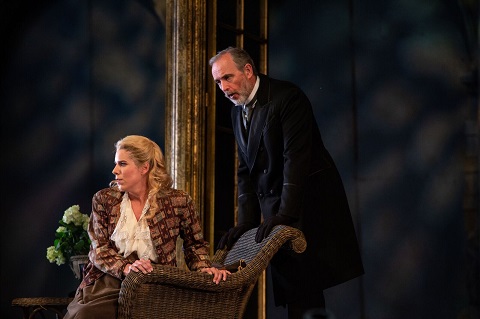 Lauren Fagan as Violetta and Stephen Gadd as Giorgio Germont. Photo credit: Ali Wright.
Lauren Fagan as Violetta and Stephen Gadd as Giorgio Germont. Photo credit: Ali Wright.
Though the spotlight shines firmly on the central, fraught triangle, the minor roles all make their mark, for the unfussy staging gives them room to find their ground and occupy it. Laura Woods is a minxy Flora, her voice full of colour and lushness; Charne Rochford as Gastone and Nicholas Garrett’ as Douphol define their characters well.
Although the overture sounded somewhat thin and lacking in sentiment, conductor Matthew Kofi Waldren encouraged ever more responsive playing from the City of London Sinfonia and the precision of the playing in the final Act was complemented by impassioned warmth. Waldren doesn’t hang about and that only serves to enhance the sure dramatic thrust established by Gaitanou and Chisholm.
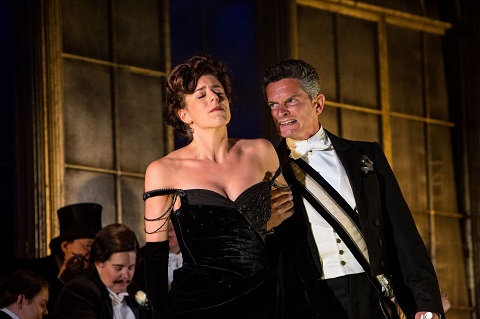 Lauren Fagan as Violetta and Nicholas Garrett as Barone Douphol. Photo credit: Robert Workman.
Lauren Fagan as Violetta and Nicholas Garrett as Barone Douphol. Photo credit: Robert Workman.
In the closing scene, the reflections in Chisholm’s glass evoke fore-shadowings of Violetta’s ghostly form - as if she is haunting the stage even while she still struggles to draw her last, irregular, painful breaths. The recording of shallow consumptive breathlessness echoes disturbingly in the memory.
Despite the Parisian partying and pleasures, Gaitanou’s La traviata is permeated with the shadows of disease and death. Fagan’s Violetta is both frail and fervent; the fever of love and illness burn with equal intensity. It’s a paradoxically uplifting blend.
Claire Seymour
Violetta - Lauren Fagan, Alfredo - Matteo Desole, Giorgio Germont - Stephen Gadd, Flora - Laura Woods, Annina - Ellie Edmonds, Gastone - Charne Rochford, Barone Douphol - Nicholas Garrett, Marchese d’Obigny - David Stephenson, Dottore Grenvil - Henry Grant Kerswell, Giuseppe - Robert Jenkins Flora's Servant - Ian Massa-Harris, Messenger Alistair Sutherland; Director - Rodula Gaitanou, Conductor - Matthew Kofi Waldren, Designer - Cordelia Chisholm, Lighting Designer - Simon Corder, Movement Director - Steve Elias, City of London Sinfonia and the Opera Holland Park Chorus.
Opera Holland Park, London; Tuesday 29th May 2018
Image=http://www.operatoday.com/Lauren%20Fagan%20as%20Violetta%20with%20Anina%20Act%201.jpg image_description=Il Traviata, Opera Holland Park 2018 product=yes product_title=Il Traviata, Opera Holland Park 2018 product_by=A review by Claire Seymour product_id= Above: Lauren Fagan as Violetta and Ellie Edmonds as AnninaPhoto credit: Robert Workman
The Devil, Greed, War, and Simple Goodness: Ostrčil’s Jack’s Kingdom
Otakar Ostrčil was a prominent Czech composer who has fallen into obscurity. His dates, 1879-1935, span a key moment in the history of Central Europe, for it was in 1918 that the Czech lands became part of the new country of Czechoslovakia, independent of Austrian rule. In the preceding decades, Czech writers and artists had often attempted to define a national identity for themselves, as can be heard in many works of Smetana and Dvořák. When national statehood arrived, composers took one of several paths: some modeled their work on trends within the European musical mainstream (e.g., symphonic poems in the manner of Liszt or Strauss; or neoclassicism in the manner of Stravinsky and some of Les Six), while others continued to explore ways of sounding distinctive and different, for example by writing vocal music and opera using Czech texts based on Slavic folk legends. The whole story is further enriched by the fact that Prague had a substantial German-speaking population (including many Jews), and even a German opera house, the New German Theater, which is now known—after a number of name changes—as The Prague State Opera.
Ostrčil, who established himself early on as a conductor and composer, served as the music director at the Prague National Opera (i.e., the Czech-speaking house) from 1920 till his death at the age of 56. He was greatly admired for the precision of his conducting and for the open-minded welcome he gave to a wide range of repertoire, from the comic operas of Auber to a work for which he was roundly chastised in the press: Berg’s Wozzeck. His 1933 recording of Smetana’s The Bartered Bride was at one point released on CD by Naxos but seems to have been withdrawn, perhaps for contractual reasons.
Ostrčil wrote a number of successful orchestral works and operas. Honzovo Království was the last of his operas, and the present recording is a re-release of a superlative recording made in 1954. The opera was a great success at its premiere in 1934, but Ostrčil died four months later, possibly in part because of overwork. (The often-contentious Czech musical scene during the first half of the twentieth century comes vividly to life in two scholarly books that, I should confess, I had a hand in getting published: Opera and Ideology in Prague, by Brian Locke—no relation to me!—and Bedřich Smetana: Myth, Music, and Propaganda, by Kelly St. Pierre.)
In Honzovo Království (which has been variously translated as “Johnny’s Kingdom” or “Jack’s Kingdom”), Ostrčil distinguishes himself from most Western composers by basing the libretto on “Ivan the Fool,” a quasi-folktale published in 1886 by a fellow Slav, Leo Tolstoy. The story tells of four siblings whom the Devil tries to manipulate for his own nefarious purposes. Ivan, though seemingly dim-witted, is the one who manages to out-maneuver the Devil. He ends up establishing a kingdom in which there are no wars, and people who do physically demanding labor are the first to be served dinner, whereas intellectuals and nobles (people with soft, pale hands) have to be content with whatever is left over.
Ostrčil’s librettist, Jiří Mařánek, gave the story a specifically Czech twist, in part by renaming the characters: most notably, Ivan becomes Honza, a figure clearly derived from the character in many Czech folk tales known as “Hloupý Honza,” i.e., Dull Jack. (The name Honza, like Hans in German, derives from Johannes.) Honza’s brothers are now called Ondřej (i.e., Andrew) and, a bit oddly, Ivan. The fourth sibling, a mute sister, is omitted. Honza comes across here as similar to another powerfully effective simpleton in Czech culture: the title figure in Jaroslav Hašek’s novel The Good Soldier Schweik (1921-23).
The opera is compact, taking, in this recording, only 107 minutes. The basic style reminds me at times of mid-career Prokofiev (e.g., The Prodigal Son) or the motoric ensemble scenes in Weill’s Mahagonny. On a basic musicodramatic level, the work follows certain Wagnerian procedures that had become normative for many Western European opera composers in the intervening half-century. In general, the melodic lines are conversational, requiring clear enunciation more than long-phrased breathing. There are exceptions, though, mainly in lyrical passages for Honza, the Princess (CD 2, track 3), and the slippery, multi-faceted Devil. I might recommend to enterprising lyric tenors Honza’s soliloquy that opens Scene 2.
Continuity is provided by several recurring themes and by richly elaborated interludes between scenes. (For example, the orchestral description, in Act 2, of the sadness that has gripped the kingdom because—as the Constable has just explained in spoken words—the princess is mysteriously ill: begin at 0’50”.) Passages of spoken dialogue over orchestral music, a technique known in the opera world as melodrama, depart forcefully from the Wagnerian model and help emphasize the modesty and directness of the folk-like story. (Melodrama was a technique particularly cultivated by Ostrčil’s teacher, Zdeněk Fibich.) The spirits of hell converse with the devil from all parts of the theater, using megaphones. On the recording, their speaking voices—they are trying to cook up a war in Honza’s peaceable kingdom—are made even creepier by some simple electronic reverb. (The YouTube track begins with a symphonic interlude; the conversation begins at 2’13”.)
This recording, apparently the only one that Honzovo Království has ever been granted, was made in the Prague radio studios in 1954 and was released on LP by Supraphon. (It can be heard entire, in many segments, at YouTube, but they are not arranged in any recognizable sequence.) The performance under Jiráček is vivid and presumably reflects the extensive series of staged performances that the work had received in the Czech and Slovak lands up to that point. The work was first heard in Brno, in 1934, then in Ostrava, and from 1935 onward in Prague. It was given in German in 1937 in the aforementioned German-language opera house in Prague.
The reissue of this recording on CD was made possible, according to a note in the booklet, by Astrid Štúrová-Kočí, presumably the daughter of baritone Přemysl Kočí . The latter performs the role of the Devil splendidly—acting and singing all at once, all the way through, with witty understatement rather than Boris Christoff-like overemphasis. The CD release coincides, surely not by chance, with the hundredth anniversary of Kočí’s birth. What a wonderful tribute to the memory of someone who was a major artist in Soviet-era Czechoslovakia. The Czech Radio website (radioteka.cz) offers for sale, on CD or as a download, a Czech-language performance of Mozart’s Don Giovanni with Kočí in the title role.
The other cast members come across just as vividly, including Otava, who sang his role here (Ondřej) at the opera’s first Prague production, 17 years earlier. In the meantime, Czechoslovakia had experienced almost unimaginable turbulence: occupation by the Nazis, mass deportations for forced labor in Germany, persecution of political resisters, the systematic murder of most of the Jewish population, and, in the post-war years, the expulsion of most of the German population and the beginnings of what would be four decades of repressive Communist dictatorship. I can barely imagine the many different ways that this anti-war opera may have resonated for Czechs and Slovaks in 1954.
The best-known of the singers is the tenor Ivo Žídek , in the title role. We hear him at age 28; he had been singing leading roles since 18 and would continue to expand his repertory, and to perform and record internationally, at the highest level, until age 59. His singing nicely balances secure vocal production with a serene characterization and touches of humor.
Indeed, the singing from the whole cast is light and clear, with little trace of the “Slavic wobble” that I find tiresome in many recordings from further east (e.g., Russia and Bulgaria). The spoken roles seem to be taken by professional actors: they are superbly done. The orchestra and chorus play and sing alertly. Occasionally the woodwind and brass sections are not perfectly tuned, or the brass blare a bit. The various solos for wind instruments and for violin are nicely characterized. The sound quality is high-quality mid-1950s mono: clear, no distortion, but with the orchestra a bit recessed instead of richly surrounding the voices. Essay, synopsis (with helpful track numbers), and libretto, in Czech and (mostly comprehensible) English. I would say that it is time for a more modern recording, allowing us to appreciate the power and wit of the orchestral writing more. (And of course some live performances, either on stage or in concert.) But, if the vocal performances did not show the detail and insight that they do in this recording, I suspect the work wouldn’t come across half as well as it does here.
The second CD is filled out with a recording of Ostrčil’s fascinating fourteen-section set of Variations for Orchestra, Op. 24 (1928), entitled “Křížová cesta,”which is translated on the CD box as “Calvary.” Other sources list the work’s title as “Golgotha.” Closer English approximations would be “The Way of the Cross” or “The Stations of the Cross.”
This mono recording of the Variations, by the Czech Philharmonic under Václav Neumann in 1957, may have been the work’s first. (Like the opera, it is available on YouTube in segments. Here is the opening: “The Son of Man Is Condemned to Death.”) The sessions took place in Dvořák Hall, in the famous 1886 building called the Rudolfinum. The 1100-seat hall has fine acoustics—reflected in the good clear sound—and is the home of the Czech Philharmonic (and of many Prague Spring events). A stereo recording, likewise by the Czech Philharmonic under Neumann, was released on CD in 1990 and re-released in 1995. Carl Bauman, in the American Record Guide, at first found the work “bombastic” but, upon re-listening, discovered “various beauties” in it (March/April 1995). Each of the work’s fourteen short sections is headed with a descriptive phrase describing a moment from Christ’s last days, beginning with his being condemned to death and ending with his entombment. The booklet essay suggests that Ostrčil identified with Christ because of how he himself had suffered for the art he loved.
The musicologist Martin Nedbal informs me that there have been, for centuries now, “Calvary hills” constructed throughout Europe, including several in what used to be Czechoslovakia. A Calvary hill often consists of a cross (or three crosses) on a hill, and other markers and chapels on the way toward the hill, for pilgrims who wish to reenact and ponder Jesus’s last journey.
I found the 31-minute-long piece continuously engaging, especially when I remembered to keep in mind the titles over each of the fourteen sections: for example, in section 4, Jesus meets his mother Mary (Mahlerian sorrow, beginning with the strings alone and then broadening out) and, in section 7, he collapses for a second time under the weight of the Cross (much thrust and intensity, full orchestra). The work follows the traditional list of 14 Stations (some based on medieval legends), not the more carefully scripture-derived versions authorized by Pope John Paul II in 1991 and by Pope Benedict in 2007 (which purge, for example, the episode of Saint Veronica wiping Jesus’s face with her veil—Ostrčil’s section 6).
I am not sure I’ve yet fully grasped the variation process here, aside from a very noticeable rising motive that begins most of the fourteen sections. I was more aware of the expressive contrasts from one section to another. Still, I look forward to listening again to this remarkable case of a programmatic orchestral work that conveys a message at once religious and highly personal.
I continue to be surprised to find so many fine, even exciting musical works that are floating “out there” yet rarely, if ever, get performed in North America. I am grateful daily to Thomas Edison and his followers who perfected the medium that gives me so much joy and emotional gratification—including these two works by a composer who was to me, until now, just a name in books.
Ralph P. Locke
The above review is a lightly revised version of one that first appeared in American Record Guide and appears here by kind permission.
Ralph P. Locke is emeritus professor of musicology at the University of Rochester’s Eastman School of Music. Six of his articles have won the ASCAP-Deems Taylor Award for excellence in writing about music. His most recent two books are Musical Exoticism: Images and Reflections and Music and the Exotic from the Renaissance to Mozart (both Cambridge University Press). Both are now available in paperback, and the second is also available as an e-book.
‡ Click here for a review of Laci Boldemann’s Black Is White, Said the Emperor. Click here for a review of Ravel’s L’enfant et les sortilèges.
image=http://www.operatoday.com/0099925422424.png image_description=Supraphon SU 4224 product=yes product_title=Otakar Ostrčil: Honzovo Království, opera; and “Calvary” Variations, for orchestra product_by=Jaroslava Vymazalová (Princess), Ivo Žídek (Honza), Přemysl Kočí (Devil), Josef Celerin (Father), Antonín Votava (Ivan), Zdeněk Otava (Ondřej), Jaroslav Veverka (King), Milada Jirásková (Ivan’s wife), Ludmila Hanzalíková (Ondřej’’s wife). Prague Radio Symphony and Chorus, conducted by Václav Jiráček (in the opera); Czech Philharmonic, conducted by Václav Neumann (in the Variations) product_id=Supraphon SU 4224 [2 CD] price=$19.99 product_url=https://www.amazon.com/gp/product/B0718YX88Q/ref=as_li_tl?ie=UTF8&tag=operatoday-20&camp=1789&creative=9325&linkCode=as2&creativeASIN=B0718YX88Q&linkId=35bc9963c52b790defc8d190bf742113May 29, 2018
Iestyn Davies and Fretwork bring about a meeting of the baroque and the modern
All of Davies’ astute musicianship, technical expertise and expressive sensitivity was in evidence in Purcell’s song, compressed within four minutes of exquisite musical rhetoric. The twists and leaps of the ascending ground bass were articulated with lyricism as Davies let the descending melodic phrases fall silkily. His care with the text was both exemplary and thoughtful: a frisson on ‘beguile’ in the first phrase was transferred to the repetitions of ‘for all’ in the second. The snakes dropped from Alecto’s head as if slipping into cold water. The reiterated pledge of the closing phrase was dusted with a dash of piquancy by the upwards appoggiatura at the final cadence and by the suggestive lingering of the voice, the slightest vocal resonance persisting beyond the viols’ silence.
Interested readers can turn to my recent interview with Iestyn Davies for his (and my) thoughts about the musical threads that tether the baroque and minimalism together across three hundred years of changing musical forms and language, as well as for details about the origins and first performances of the works by Nyman included in this programme.
In her programme article, Alexandra Coghlan suggests that, although they share a ‘common vocabulary’, what distinguishes Bach and Purcell, say, from minimalists such as Glass and Nyman, is the use to which the composers put such means: that is, the repetitions of a Purcellian ground bass result in an intensification of emotion whereas the gyrations of minimalism serve ‘to strip away emotional as well as musical landmarks, to nullify, to hypnotise’.
I think that in some contexts this is probably true. But, this concert suggested that a more nuanced comparative relationship and dialogue is at work: that it is ‘time’, or rather the dialectic between timelessness and movement, which is at the core of both baroque and minimalist idioms, but that composers from these respective eras explore and articulate concepts of rest and unrest, stillness and progress, in different ways. Emotion, and its intensification, is present in both idioms, but the arousal of such emotion is achieved by contrasting methods of manipulating repetitive structures - whether structural, harmonic or motivic - as these features engage with other musical elements.
Or, as Iestyn Davies himself put it, with more directness, both Purcell and Nyman seem to contrive to deliberately make us aware of the passing of time. The works performed here certainly seemed to exemplify the way that Purcell’s emotional intensification and rhetorical ‘progression’ is effected by what I previously described as ‘ever more complex, nuanced elaboration, and more radical re-interpretation of harmonic structures and inferences’, while Nyman’s music acquires accumulating intensity, and restlessness, through amendments - sometimes unexpected - to the ‘episodic reiterations’ which results in forward movement of a sometimes physically shuddering nature.
The programme was framed by two works by Nyman for countertenor and viols. The seven short metaphysical epigrams, ‘To Music’, by Robert Herrick which Nyman sets in the form of a continuous unfolding in No Time in Eternity, immediately foreground the seventeenth-century representation of music as something active, with the power to effect varied change - by turns redemptive and destructive, enchanting and decadent. ‘Begin to charm’ is the initial, repeated cry, as the poet calls upon Music to first ‘melt me into tears’, then ‘make my spirits frantic’ and finally ‘make me smooth as balm and oil again’. Davies instantly cast an Orphic spell. The purity of his countertenor as he reiterated the opening word, ‘Begin’, set against the quiet, dark graininess of the viols’ gently propelling rhythmic gesture, and the intensification of chromatic false relations, beautifully embodied the sensual impact of Herrick’s ‘silvery strain’.
And aptly too, for, as the title implies, Herrick is concerned with the human, the ‘body’, rather than with the ethereal: ‘By hours we all live here;/ In Heaven is known/ No spring of time, or time’s succession.’ Herrick’s text emphasises the seventeenth-century concern with the unequal relationship between the music of the world and the music of the spheres on which it is based. The cold sparsity of the viol textures and voice-viol unisons in ‘Things Mortal Still Mutable’ emphasised the dangers that uncertainty and change bring to man, who is set on ‘icy pavements’, as well as the inevitable progression of musical phrase upon musical phrase. I was struck, too, by the clarity and shapeliness of Nyman’s melodic definition in ‘The Definition of Beauty’ - ‘Beauty no other thing is than a beam/Flashed out between the middle and extreme.’ - and by Davies’ diction and eloquence here. The epigrammatic fragment conjured in my mind the text-setting of Benjamin Britten, particularly the early works such as Hymn to St Cecilia, another poetic mediation on the nature of music and its power: ‘Translated Daughter, come down and startle/Composing mortals with immortal fire.’
Nyman’s Self-Laudatory Hymn of Inanna and her Omnipotence - written for and first performed by Fretwork and James Bowman - drew forth contrasting but complementary skills from Davies and Fretwork. Sustained high declamatory utterances, relentless octave leaps, melismatic unpredictability, excursions into the singer’s lowest register which emphasise Inanna’s princely status - ‘He has given me lordship’: all these musical elements captured the power-hungry egoism of the Sumerian Queen, the ancient goddess of love, sensuality, fertility, procreation and war - and all were effortless despatched by Davies. Fretwork added drama to the rhetorical pronunciations of identity and self-belief: shimmering upper viols and brusque pizzicato sweeps; folk-like circulatory gestures which whipped up energy in the middle voices; driving repeated groups of semi-quavers; unison crystallisations of the self-belief confirmed by forceful repetitions, ‘is mine’.
In two songs ‘If’ and ‘Why’, written by Nyman to texts by Roger Pulvers for inclusion in director Seiya Araki’s 1995 animated film, The Diary of Anne Frank, even these supreme musicians could not quite overcome the banality of Pulvers’ texts which express a child-like hope - ‘I’d blink my eyes/And wave my arms./I’d wish a wish to stop all harm’ - but whose anaphoric pleas (‘Tell me why, somebody … Why people can not love./ Why people hate all day and night/ […] Why adults fight over God/Why adults fight over colour/ Why adults go to war.’) have the ring of a collective classroom poetry project. That said, the looseness of the musicians’ crafting of Nyman’s ostinatos, which slip between time signatures and across varied phrase lengths, added some thought-provoking depth to the general consonant sweetness.
More interesting was Nyman’s Music after a while for viol consort, receiving its world premiere, for it offered a direct dialogue between present and past. Nyman begins with a sort of retrograde inversion variant on Purcell’s ground, the semitone falling rather than rising, before leaping up a fourth (not a fifth), and the distortions are further exacerbated by the irregularity of the rhythmic values in contrast to Purcell’s steady progression. The result is an increased frustration, as the motif seems to fight against itself rather than simply accumulate intensity as it moves forward. Gradually, the rhythmic figuration and syncopated tension increase, and the drama derived from growing the harmonic complexity and revolving deep bass line was enhanced by the delicious airiness of the viol players’ bow strokes which seemed to fly and float across the strings. Purcell’s ground, in its original form, increasingly made its presence felt, though it had to fight through chromatic obstacles and fast viol figures in the upper voices to sustain itself, and such dialogues resulted in rhythmic disjunctions which were eventually subdued into unisons and steadiness of pulse. This was a thrilling conversation between a ghostly voice and a present scribe.
However, the highlight of the concert was, inevitably perhaps, the beauty of Davies’ countertenor - for which I don’t really have the words, which is probably as it should be. Purcell’s ‘An Evening Hymn’ had closed the first part of the recital with hypnotic reverie. The encore was ‘O Solitude’, the 28 ground-bass repetitions of which - of infinite expressive variety, imaginative re-interpretation, formal flexibility - surely issue a challenge to any composer, baroque or minimalist. It’s hard, too, to imagine a text - Antoine Girard Saint-Amand’s ‘O que j’ayme la solitude!’, translated by Purcell’s contemporary, Katherine Philip - more diametrically opposed to the self-aggrandising oratory of the Sumerian warrior-Queen which had preceded it. Davies, accompanied initially by lute-mimicking pizzicatos then by graceful viol interweaving, was Orpheus Britannicus indeed.
Claire Seymour
Iestyn Davies (countertenor), Fretwork (Asako Morikawa, Joanna Levine, Sam Stadlen, Emily Ashton, Richard Boothby)
Michael Nyman - No Time in Eternity; Purcell - Two Fantazias in four parts, ‘Music for a While’; Nyman - Music after a while; Purcell - ‘An Evening Hymn’; Nyman - Balancing the Books, The Diary of Anne Frank (‘If’, ‘Why’); Purcell - Fantazy in four parts and Fantazy upon one note (1680); Nyman - Self-Laudatory Hymn of Inanna and her Omnipotence.
Milton Court Concert Hall, London; Monday 28th May 2018.
Image=http://www.operatoday.com/%C2%A9Chris%20Sorensen_4.jpg image_description=Iestyn Davies and Fretwork at Milton Court Concert Hall, 28th May 2018 product=yes product_title=Iestyn Davies and Fretwork at Milton Court Concert Hall, 28th May 2018 product_by=A review by Claire Seymour product_id= Above: Iestyn DaviesPhoto credit: Chris Sorensen
May 27, 2018
BLACK OPERA: HISTORY, POWER, ENGAGEMENT
From the University of Illinois Press:
image=http://www.operatoday.com/9780252083570_med.png image_description=BLACK OPERA: HISTORY, POWER, ENGAGEMENT product=yes product_title=BLACK OPERA: HISTORY, POWER, ENGAGEMENT product_by=By Naomi André product_id=ISBN: 978-0-252-08357-0 (paper) price=$27.95 product_url=https://www.amazon.com/gp/product/0252083571/ref=as_li_tl?ie=UTF8&tag=operatoday-20&camp=1789&creative=9325&linkCode=as2&creativeASIN=0252083571&linkId=9520633c597f6b6ec8006d5d7d4b29b4From classic films like Carmen Jones to contemporary works like The Diary of Sally Hemmings and U-Carmen eKhayelitsa, American and South African artists and composers have used opera to reclaim black people's place in history.
Naomi André draws on the experiences of performers and audiences to explore this music's resonance with today's listeners. Interacting with creators and performers, as well as with the works themselves, André reveals how black opera unearths suppressed truths. These truths provoke complex, if uncomfortable, reconsideration of racial, gender, sexual, and other oppressive ideologies. Opera, in turn, operates as a cultural and political force that employs an immense, transformative power to represent or even liberate.
Viewing opera as a fertile site for critical inquiry, political activism, and social change, Black Opera lays the foundation for innovative new approaches to applied scholarship.
May 26, 2018
Works by Beethoven and Gerald Barry
The first half, however, put one in mind of that proverbial, clichéd curate’s egg. Adès walked onto the stage and apologetically informed us that two works had been added to the programme. Nothing wrong with that, although Beethoven hardly requires apology. The first was his Six Ecossaises, WoO 83, which many of us will recall from childhood piano lessons. Adès’s performance proved a curious mixture of the reticent – as though he would rather be playing the dances at home – and the heavy-handed. It became more flexible, to good effect, as it went on. Ultimately, though, little was made of these charming miniatures, whether individually or as a whole.
An die ferne Geliebte followed, Adès continuing to show a good deal of reticence, for most of the time very much the ‘accompanist’. Allan Clayton offered a sincere, verbally attentive performance until the final song, in which he sounded curiously harsh of tone, even hectoring. Still, there was a good deal to savour, for instance a true hint of sadness at the close of the fifth stanza of ‘Es kehret der Maien’. Adès seemed to come into his own as the cycle progressed. If he still came across as shadowing the singer at the beginning of ‘Leichte Segler in den Höhen’, his shaping of a minor-mode phrase at the end of the third stanza – ‘Klagt ihr, Vöglein, meine Qual’, offered just the sort of touching insight I had hoped he would bring to the music of a composer with whom he is not so obviously associated. The transition to the next song, ‘Diese Wolken in den Höhen’ was also skilfully handled.
The second additional work was In questa tomba oscura, WoO 133, Beethoven’s setting of a poem by Giuseppe Carpani, amongst other things an early biographer of Haydn (and royalist spy!) This proved a duly haunting performance of a song whose text has a man visit the grave of his beloved, albeit from the standpoint of the latter, who reproaches her lover for not having thought more of her whilst she was alive. Perhaps again Adès might have brought out the piano part more strongly. Beethoven’s harmonies nevertheless told – and there is much to be said for understatement. Clayton clearly relished its challenges, heightening without overstating its curious drama.
‘Curious’ is certainly a word to be applied to Lewis Carroll, and to Gerald Barry, let alone to their combination in Jabberwocky , commissioned and premiered by Britten Sinfonia in 2012. The idea of performing its nonsense words in French and German translation is typically brilliant – and makes just as much (non)sense as the original. Clayton’s declamatory performance perhaps inevitably put one in mind of Barry’s brilliant operatic comedy, The Importance of Being Earnest. Alex Wide’s bizarre horn flourishes added another level to the studiously inexplicable entertainment unfolded. The song – should one call it a ‘song’? – seemed, almost in spite of itself, to grow, even to develop. And then it was over.
Additional wind players joined the ensemble after the interval for Beethoven’s Quintet for piano and wind instruments, op.16. It was the sheer gorgeousness of their sonorities that struck me first – and Beethoven at his most Mozartian (or, his tragedy, post-Mozartian). Balance with the piano here sounded much improved; there was greater impetus to the performance too. This is music that needs plenty of space, a grandeur of scale if you will, as well as chamber intimacy; it received both. The second movement was again well paced, its post-Mozartian sadnesses again given space to breathe, yet also to progress. Here, Adès could prove a little indulgent, his solo rubati occasionally puzzling; in concert, however, everything delighted. The hunting finale again summoned up Mozart’s ghost – as opposed to Haydn’s ebullience. Yet, quite rightly, not all was subtlety, not all was interiority. That balance and others were finely judged, in a performance of almost tiggerish enthusiasm.
Mark Berry
Programme:
Beethoven: Six Ecossaises, WoO 83; An die ferne Geliebte, op.98; In questa tomba obscura, WoO 133; Gerald Barry: Jabberwocky; Beethoven: Quintet in E-flat major, op.16. Allan Clayton (tenor); Alex Wide (horn); Timothy Rundle (oboe); Joy Farrall (clarinet); Sarah Burnett (bassoon); Thomas Adès (piano). Milton Court Concert Hall, London, Wednesday 23 May 2018
image=http://www.operatoday.com/beethoven.png image_description=Ludwig van Beethoven product=yes product_title=Works by Beethoven and Gerald Barry product_by=A review by Mark Berry product_id=Above: Ludwig van BeethovenMay 24, 2018
The Moderate Soprano : Q&A with Nancy Carroll and Roger Allam
What interested you about the play and taking on the role?
RA : In the first version of the play when John Christie comes on he’s described as short, fat, bald and wearing lederhosen and I thought, ‘That’s the part for me, I have to play that role’. So there’s that kind of infantile appeal of dressing up and changing one’s appearance as you can see [he says this while having his bald cap put on], that has always been an element of the appeal of acting to me. Maybe after this I’m giving it a break though [laughs]. But actually, it was getting to know the story both through the play and reading a biography of John Christie which was something I knew nothing about at all. I didn’t know how it was founded, I certainly knew nothing about how they kind of lucked out completely when the three probably best people in the world were escaping Nazi Germany, and came to work at Glyndebourne. And for me it became very clear that there was a real thing about standards, they really built and maintained standards. Whatever you feel about the ‘snobs on the lawn’ aspect of it, they raised the bar, I think, for everyone else.
NC : For me, it was telling a story about a woman who pushed her husband forward and just got on with it and even Gus Christie who currently runs the festival knows very little about his grandmother. She died in 1952 before he was born and all the stories are about his grandfather but very little is known about her. And indeed, for me as an actress to play a part that skips between 1934 and 1952 when that person was in two very, very different states is a fantastic acting challenge and that’s what interested me. And also, as a post-Brexit story the fact that this quintessentially English treasure was actually set up by two extraordinary Germans and an Austrian – as a message to the leaders of Brexit, I think it’s quite an important one…
So there’s the story of Glyndebourne as an institution…
RA : And I was also drawn in by John Christie as a character, he was the most extraordinary man. Deeply and naturally eccentric but also someone who wanted to do good, you know. I mean, in 1911 when he was 29 he had a car – when there weren’t that many cars on the road – a Daimler, and he took a trip to Bayreuth and he took two friends, two Eton schoolmasters, with him and there were no car ferries then of course, so the car was put on a barge and the barge was towed by a ferry and the three men sat in the car on the barge going across the channel and then drove to Bayreuth. I mean, it’s just rather wonderful. And he had a building company, he had an organ company, he installed electricity in Glyndebourne…
NC : I think he had an entrepreneurial, scientific mind and although he believed in hierarchy in so many ways, he also did extraordinary things, like he created a library for his staff at Glyndebourne because he believed that information and education should be for everybody…
Yes, his idea of opera as public service is an interesting one.
NC : But then it was always… in Italy, in Germany – it was popular music. It’s only in this country that we’ve created this sort of… it’s like Shakespeare really… you know it sometimes seems to before the educated and higher classes, which is nonsense. Shakespeare, although he was middleclass, was an actor working in theatres, in London, around the country, and they were playing to people, to every single class, it’s how it should be. It’s beautiful music – why should it be for one set of people and not another?
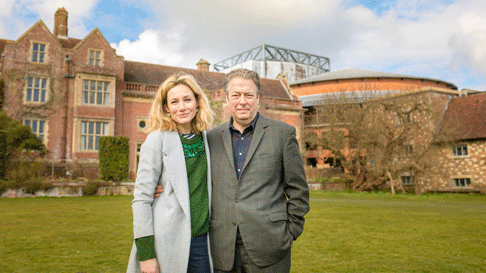 Nancy Carroll and Roger Allam at Glyndebourne [Photo © Piers Foley]
Nancy Carroll and Roger Allam at Glyndebourne [Photo © Piers Foley]
You visited the Glyndebourne archive when preparing for the role. What was interesting about that, what did you uncover?
NC : It was interesting to see lots of photographs of them, between 1934 and 1952 and the difference in her physicality, because she was in so much pain by then. But the photographs that I found fascinating were the 1934 ones when they were completely in their element and the kids were small – and when she was pregnant with their second child, they looked idyllically happy. And then 1952 he was still thriving and she was obviously much more sort of, held, and then 1962 when he was very ill he grew a big beard because he couldn’t shave any more…
RA : Also the difference in the building, the expanding opera house, so that every year from 1934 you look at the photographs, something has been added so that by the 1960’s they’d done lots of extensions, put in many rehearsal and dressing rooms, they put a gallery in the theatre… I think it ended up seating about 800 and started off at around 300. And the current building was built in the 90’s…
NC : The thing I loved in the second rehearsal period is that we were visited by John Cox who had assisted Carl Ebert and who was able to give us first hand knowledge of what it was like in its heyday. He said it was incredibly moving how committed everybody was and what an extraordinary ethos they had, which was very much the work of John Christie, of the two of them really -the family had an incredible ethos of creating a safe haven for singers, where they had these long rehearsal periods, and people were invited to stay in the family home and were treated as family. Everybody who was there felt incredibly loyal to the place, and John Christie had this incredible loyalty to people. So, he couldn’t have experienced that without going there and seeing this…. It was incredibly moving. And I think this is what the place inspires, it’s what the dream inspires.
Did you get to hear Audrey Mildmay singing?
NC : I heard Audrey Mildmay singing and that was just beautiful and it was really lovely to read some of her reviews from 1934, 1935, 1936 and everybody would always comment on the delicate honesty of her voice which in the play Rudolf Bing describes as Ausstrahlung, which is this essence, something about her which radiated, something from deep inside her that came out in her voice – but it didn’t have the power to fill a bigger space which is why Christie refers to her as a moderate soprano. There was this lack of power but actually the quality of the voice was very, very beautiful, and it was lovely to hear that. And one of the things I loved was seeing her travelling with her trunk when she was touring with the Carl Rosa company before she married John. There’s something about playing somebody who existed like that…
You mentioned you heard recordings of John Christie too…
RA : Yes, it was very useful to hear his voice but I can’t represent it accurately on stage because it would be too slow, as he was much older then, so I have to kind of invent something, but I invented it with the knowledge of what his voice sounded like when he was older which was great. And it was also great to be in Glyndebourne to soak up the atmosphere of the place.
So overall, a story worth telling?
NC: I think the main thing is it’s a fantastic story and so unexpected. The way that David [Hare] has written it… I think it comes to the audience almost like a stream of consciousness. Bob Crowley calls it a memory play but that suggests a gentleness and it’s not a gentle story. It’s robust and it’s about people passionately trying to make art. And I think that’s what interested David as well, as somebody who from a very young age worked against the odds to tell stories that he felt needed to be told and show the other side of the argument. It’s a beautiful thing and it comes at an audience from so many different angles so that at the end of two hours you’ve formed a picture, but it’s not a linear one – and that’s what makes it so interesting.
image=http://www.operatoday.com/Glyndebourne-archives.png image_description=Nancy Carroll and Roger Allam product=yes product_title=The Moderate Soprano : Q&A with Nancy Carroll and Roger Allam product_by=An interview by Mahima Luna product_id=Above: Nancy Carroll and Roger AllamLe Concert Royal de la Nuit - Ensemble Correspondances
Le Concert Royal de la Nuit was a statement so extravagant that it stunned the unruly Court into submission. As an artistic manifesto, it set out visions of what music, theatre, visual arts and dance might achieve. From Le Concert Royal de la Nuit, we can trace the origins of the arts as we know them today, not only in France, but in European culture as whole, with implications so wide that they are still felt today. Sébastien Daucé and Ensemble Correspondances made an acclaimed recording a few years back, and have been performing it in semi-staged productions, with dancers. No wonder St John's Smith Square was almost sold out!
The original Concert Royal de la Nuit ran over 13 hours,from dusk to dawn, though there were breaks for feasting and rest. For practical purposes, this version comes in four Veilles (Watches) and 67 individual parts, ending with a Grand Ballet, running around 2 1/2 hours. But what variety ! There are pieces for different groupings from soloist with orchestra to full ensemble, scenes of high drama and moments of quiet contemplation, marking the transition from night to day. At the beginning, the beating of a single drum, a reminder that the pulse of music is rhythm, and that life itself marches to a rhythm that is greater than any individual. Despite the glories that are to come, pastoralism - and war - are never far away. As King, Louis XIV represented idealized virtues of manliness and refinement, strength and benevolence. The dances at court were structured displays, and dance itself a form of physical fitness and mental discipline. This idea of orderly logic would flow through to design, philosophy, and much more.
But Nature remains present. Like the gardens which Louis XIV would layout at Versailles, nature is contained in defined formal patterns, but in the woods surrounding, nature runs free. A hibou calls (a small archaic pipe) marking the descent into night. "Languissante clarté", the first Récit, in which The Night reveals herself, a showpiece for Lucile Richardot, who projected the long, flowing legato so it seemed to fill the hall like moonlight. Behind her, murmuring low strings, sussurating like creatures of the night.Richardot has amazing timbre and range, her voice so expressive that she can "act" with her voice, though here she uses hand gestures reminiscent of those used in drawings of the original performance, an inportant consideration given that Le concert royal was meant to unify visual and aural art. This was followed by pieces marking the passing of "Hours" (soprano and small groups) and vignettes depicting huntsmen, gypsies and peasants, all well characterized.
The shades of darkness descend in the second Veille, and Venus appears, risen fully formed from the sea. This is a pointed reference to Louis XIV, taking command at the age of 14, throwing off the authority of Cardinals and courtiers. Though the Three Graces sang the praises of Venus, the connections must have been obvious. Thus choruses of Italians and Spaniards (rivals of the French) praise "unvanquished France", united behind the leadership of Louis "Le plus Grand des Monarques", as Venus herself declared. If the Moon symbolizes purity, Hercules symbolizes manly heroism. The Third Veille is a panorama where countertenor, bass, and male and female voices interact with orchestral interludes, replete with dramatic sound effects (instruments suggesting wind and thunder). The contrast between countertenor and bass was particularly vivid, performed here with great brio, the orchestra equally animated. Greek Gods, witches and figures from Antiquity emerge but the real subject is clearly Louis the King. Venus and Juno have extended récits which acknowledge opposition but posit that a strong, benevolent ruler can triumph. The "love" here means love for an absolute King. Also extremely effective, the trio of male voices in the Chorus of Brooks and Breezes, "Dormi, dormi, o Sonno, dormi". The last Veille describes Orpheus's entry into the Underworld. Hero as he is, he cannot defy the laws of Life and Death. Night symbolizes sleep, dreams and submission, to Fate, Time and Nature. Then Apollo appears, promising the retun of "mio figlio", the sun and Spring.
This set the context for the Grand Ballet, where Louis XIV himself appeared, garbed in golden splendour as the Sun, his headress emanating rays of light."Depuis que j'ouvre l'Orient" the récit of Aurore - beautifully sung and phrased by tenor, "jamais si pompeuse et si fiere......Le Soleil qui me suit c'est le jeune LOUIS". The Chorus, representing the Planets hail the king. Now the orchestra burst forth with full enegy, percussion announcing the triumphal procession of the King into centre stage. The rhythmic energy of these orchestral interludes suggests that Louis XIV was an accomplished athlete - nothing wimpy about that dancing. Hercules and Beauty (baritone and soprano) united to sing of "Altro gallico Alcide orso d'affecto". Cosmic forces indeed! Glorious final chorus, "All'impero d'Amore hi non cederà, S'à lui cede il valore d'ogni deità". The effect must have dazzled the Court of Louis XIV, blinding them into silence. Le Concert Royal de la Nuit marks the start of music, theatre, dance and opera as we know them now, but also marked a turning point in French history. Ensemble Correspondances have been performing Le Concert Royal de la Nuit in staged performance, complete with dancers, in recent years (premiering in Caen), so let's hope a miracle happens and we might get to see it in London. (William Christie and Les Arts Florissants have done a shortened unstaged version but with dancers). Until, then, give thanks and praise to Saint John's Smith Square and above all to the London Festival, of Baroque Music who had the courage to sponsor this remarkable series. Support their commitment and dedication !
Anne Ozorio
image=https://upload.wikimedia.org/wikipedia/commons/thumb/9/97/Louis_XIV_habill%C3%A9_en_soleil.jpg/256px-Louis_XIV_habill%C3%A9_en_soleil.jpg
image_description=
product=yes
title=
product_by=Le Concert Royal de la Nuit : Ensemble Correspondances, Sébastien Daucé, London Baroque Festival, St John's Smith Square, London. 19th May 2018 A review by Anne Ozorio
product_id=Above: Louis XIV, Le Roi Soliel
May 23, 2018
Voices of Revolution – Prokofiev, Exile and Return
The Philharmonia’s ‘Voices of Revolution’ concert series, programmed in the wake of celebrations for the hundredth anniversary of the October Revolution, reached its climax with a performance of Prokofiev’s Cantata for the Twentieth Anniversary of that revolution. First, however, we heard two highly contrasted works by the composer from 1917 itself: the much shorter cantata, Seven, they are Seven, and the First Violin Concerto (on whose material he had begun work two years earlier).
Seven, they are Seven (Semero ikh) received an exhilirating performance under Vladimir Ashkenazy, conductor of the entire series, joined by the equally fine David Butt Philip, Philharmonia Voices, and Crouch End Festival Chorus. Talk about starting in medias res! Here was a Russianised hymn to Mesopotamian paganism such as few of us, however feverish our imaginations, might otherwise have imagined, albeit with a materialist, nihilist bent the performers could not and should not shake off: the Scythian Suite rendered choral and, somehow, both more and less austere. Prokofiev’s clamour for a spirit world in which he clearly did not believe – hints of something later in the programme, or not? – looked forward to The Fiery Angel, and perhaps even beyond. Perhaps, though, the deepest, darkest music came with the relative hush towards the close: ‘Spirit of Heaven, conjure them’.
That Silver Age dying away into nothing seemed apt preparation for the Violin Concerto’s celebrated silver opening. ‘Febrile’ is a word I am sure I overuse. It is difficult, however, not to resort to it in describing Pekka Kuusisto’s performance, full of the most intense – perhaps, for some, too intense? – variegation in articulation and phrasing. Unfashionably, I have always preferred the concerto’s G minor successor; if this performance did not change my mind, it came closer than most and, indeed, seemed almost to highlight what the two works have in common rather than what distinguishes them. Moreover, its side-slipping harmonic progressions, especially in the first movement, seemed almost to incite metrical equivalents. The second movement proved truly a twentieth-century scherzo, with the musical – and technical – consequences implied. Bitter-sweet lyricism and much else one could imagine, whether a priori or a posteriori, characterised the finale. Kuusisto’s despatch of Prokofiev’s double-stopping was despatched with almost diabolically casual ease, he and Ashkenazy shaping and characterising the movement to a tee. Kuusisto’s encore improvisation on a Russian folksong, ‘Midnight in Moscow’, was perhaps for fans only – but he clearly, far from unreasonably, has a good few of them.
Then came the Cantata grand finale. Ashkenazy seems to have had it about right in an interview with The Daily Telegraph – remember when that was still occasionally a serious newspaper? – in 2003, telling Geoffrey Norris that the composer had ‘kind of welcomed what was happening in Russia and wanted to see the brighter side. He didn't want to see the tragedy. With this welcome back into his country, he felt he should do what the country wanted him to do.’ More specifically concerning the Cantata, Ashkenazy continued, ‘it wasn't … an obligation ... Some people say that he wanted to mock, but I don't think so. It's a great piece, one of his greatest achievements. His attitude was just to go along with the general flow.’ It is a fascinating piece, certainly; I am not entirely convinced that it was one of his greatest achievements, but it is far, far too good not to hear. And how the world has moved on since that interview: bar a few irreconcilables on the Right, we are mostly communists again now, albeit of very different stripes, from ‘fully automated luxury queer space’ to something a little more traditionally Stalinist. If the point, as Marx maintained in his Theses on Feuerbach, as heard here, were not just, as philosophers had done, to interpret the world, but to change it, then the progress socialism has made in just the last few years augurs well indeed. It still seems a little odd, perhaps, to watch a Festival Hall full of Home Counties concert-goers, celebrating Leninism, but none of them seemed to have a problem with doing so. Good for them, for who, in what is also Marx 200 year, is not now in some sense a Marxist? At any rate, surely none of us would have the grimly negative imagination – or perhaps you would? – to dream up a neoliberal cantata celebrating, say, Hayek, Thatcher, and May: perhaps one of those curious ‘Hecklers’ who once disrupted Birtwistle performances? Trump, perhaps, albeit in a gaudier, more ironic fashion: perhaps a commission for Helmut Lachenmann. As for a Blairite Third Way…
The opening sounded as if a socialist realist-ish Boris Godunov, the Philharmonia brass commendably ‘Russian’ in tone, albeit without raucousness. Whether that lack of roughness were an entirely good thing one may wonder; it is certainly Ashkenazy’s way. Listening afterwards, for instance, to Valery Gergiev in Rotterdam, I found more variety, perhaps something deeper, but it would be churlish to complain unduly, in what remained a highly accomplished performance. For Prokofiev’s late (late for him, that is) modernistic fragmentation retained degrees both of revolutionary disconcertion and of traditional grounding: surely Beethoven’s Ninth in the cellos that prepare the way for the choral entry: ‘massive’ here in every respect. Frozen, then thawing strings seemed also to pave the way for the ‘patriotic’ world soon to come, of Alexander Nevsky and Ivan the Terrible. Russia or socialism? You decide – or rather, Stalin will. Factory metal resounded, a reminder, perhaps of Mosolov, heard earlier in the series?
The lack of belief, in a strict sense, is quite different here from that of Shostakovich, and sounded as such. Whatever we think of the latter composer as ‘dissident’ or anything else, Prokofiev’s personality, musical and political, was of a very different nature, as side-slipping as those harmonies, which is not to impute cynicism, but perhaps to return us to Ashkenazy’s observations. (He, after all, unlike most of us, lived in the USSR.) And, just as in the Violin Concerto, Cinderella called too. There are no straight lines to draw in Prokofiev’s career; he did not come to write as he later did only on account of ‘external’ pressures. For there was belief of a sort: on hearing ‘We vow to you, Comrade Lenin…’ we did – if only, to quote Ashkenazy, ‘kind of’, at least whilst in thrall to Prokofiev’s stream of consciousness. Deafening: almost. Extraordinary: certainly.
Mark Berry
image=http://www.operatoday.com/Sergei_Prokofiev_circa_1918_over_Chair_Bain.png image_description=Sergei Prokofiev, 1918 [Source: Wikipedia] product=yes product_title=Voices of Revolution – Prokofiev, Exile and Return product_by=A review by Mark Berry product_id=Above: Sergei Prokofiev, 1918 [Source: Wikipedia]Charpentier Histoires sacrées, staged - London Baroque Festival
Religion as theatre : and why not ? Like the architecture and ornamentation in baroque churches, devotional art served faith. Although St John's Smith Square was built in the less florid Northern Baroque style, Huguet's production transformed it, so it glowed. It felt as if we had stepped into a painting by Caravaggio or Velázquez.
Charpentier's Histoires sacrées have their roots both in sacred oratorio and in the mystery plays of the Middle Ages. Charpentier's audiences were well versed in biblical and liturgical texts, so they could appreciate these "stories" told with sophistication. At the heart of this programme were three histoires - Judith ou Béthulie libérée H.391, Madeleine en larmes H.343 and Cécile Vierge et Martyre H.397, framed by Ô Sacrement de Piété H.274, as prelude, Au parfum de tes onguents H.510) as interlude and Sous l’abri de ta miséricorde H.28 as postlude. This formal structure connects the three central characters, each of them a strong woman : Judith kills the Assyrian Holofernes who persecutes the Hebrews, Magdalena sings of her love for Christ and St Cecilia is martyred because she will not renounce her faith. Their stories are told through dramatic recitative, interspersed with choral and instrumental commentary and spoken narrative. While Judith's story is the most developed, with many sections and variations, the others have individual character. Magdalena's relatively short song is introduced by the vocal interlude, which mentions "scented oils", thus enhancing, figuratively, her odour of sanctity. The section about St Cecilia is bright and defiant, like the flames which devour the saint’s body, but not her soul. Towards the conclusion, the harpsichord, breaking from continuo, sings in joyous cadenza.
Although the text was in Latin, the stories themselves aren't hard to follow, and the work as a whole is propelled by vibrant musical logic, flowing freely from superb performances by the whole Ensemble Correspondances team. Modern performances of Charpentier's Histoires sacrées were pioneered some years ago by Gérard Lesni and Il Seminario Musicale but there is still much more in this rich vein to be discovered. Sébastien Daucé and Ensemble Correspondances present these three histoires with flair, enhanced immeasurably by Vincent Huguet's production. Huguet, who worked with Patrice Chéreau, understands the innate human drama in these narratives, though they may be expressed in stylized form. Large objects that resemble rockfaces, such as we see in 17th century depictions of biblical scenes, including symbolic olive trees. The idea that painting, or art, should be "realistic" is actually quite recent, and didn't apply in Charpentier's time. The simplicity of the sets also means that they can be moved quickly and quietly, without interrupting the flow of performance. Colours are added by lighting effects. Thoughtfully, the designers made use of the configuration of the building itself, using one of the high windows behind the stage to let light shine in "from above" as so often happens in devotional painting. As daylight faded to night, nature itself became part of the narrative. The singer's movements also reflected those in religious painting - hands raised and pointed, directing attention away from the singers as themselves to the stories being told. Altogether a remarkable experience. How fortunate we were that Sébastien Daucé has brought top quality, cutting edge performance practice to London.
Anne Ozorio
image=https://upload.wikimedia.org/wikipedia/commons/thumb/b/b2/Caravaggio_Judith_Beheading_Holofernes.jpg/400px-Caravaggio_Judith_Beheading_Holofernes.jpg
image_description=
product=yes
title= Marc-Antione Charpentier : Histoires sacrées - Ensemble Correspondances, Sébastien Daucé, St John';s Smith Square, London Festival of Baroque Music, 17th May 2018
product_by=A review by Anne Ozorio
product_id=Above: Caravaggio : Judith beheading Holofernes
May 22, 2018
No Time in Eternity: Iestyn Davies discusses Purcell and Nyman
In fact, Purcell and Nyman are not ‘musical strangers’. Nyman’s soundtrack for Peter Greenaway’s 1982 film The Draftsman’s Contract had drawn on Purcellian grounds - the composer is credited on the album as ‘music consultant’ - and the original Michael Nyman Band, formed in 1976, comprised instruments old and new: rebecs, sackbuts and shawms were heard alongside a banjo, electric bass and saxophone.
The Milton Court concert programme was curated by Fretwork’s Richard Boothby, Iestyn Davies explains, and includesThe Self-Laudatory Hymn of Inanna and Her Omnipotence (1992) , written for and first performed by Fretwork and James Bowman. The text - a translation of an ancient Near-Eastern hymn - is characterised by repetitions of the Sumerian Queen of Heaven’s sweeping exaltations of self-praise. The more recent No Time in Eternity - settings of seven short poems by the 17th-century metaphysical poet, Robert Herrick - was commissioned in 2014 by another viol consort, Ensemble Céladon, and countertenor Paulin Bündgen, and first performed by them in 2016.
There are further reflections on the musical and historical past in Nyman’s Balancing the Books, commissioned for the 250th anniversary of Bach’s death and loosely based on ideas drawn from the 48 Preludes and Fugues, and in the songs ‘If’ and ‘Why’, written to texts by Roger Pulvers and for inclusion in director Seiya Araki’s animated film, The Diary of Anne Frank (1995). Alongside Purcell’s ‘Evening Hymn’ and several of the composer’s fantasias for viol, a work which intimates a direct ‘conversation’ between past and present, Nyman’s Music after a While, completes the programme.
Christina Pluhar and L’Arpeggiata have previously woven the baroque, folk and jazz into a seamless tapestry; can minimalism be interlaced into the mix? I ask Iestyn Davies what forms and methods might create dialogue between the music of Purcell and Nyman? He remarks the similarity between the lucidity of the composers’ approaches to the setting of the English language, and also the repetitive structures that provide both architectural foundations and developmental impetus; both composers seem to contrive to deliberately make us aware of the passing of time. Certainly, I am often struck by the paradoxical presence of both somewhat rarefied gravity and accumulating rhetorical passion in the works of both composers, but I wonder if the ‘forward movement’ to which Iestyn refers is created by rather different means: that is, while Purcell’s repetitions are characterised by ever more complex, nuanced elaboration, and more radical re-interpretation of harmonic structures and inferences, Nyman effects forward ‘shifts’ by amending episodic reiterations - or, as Iestyn puts it, we are often ‘jolted’ by unanticipated interruptions to the revolving patterns.
I heard Iestyn Davies and Fretwork perform at Kings Place in December 2015 when I found the textural and timbral interplay of the viol consort and the countertenor voice compelling. The latter’s purity and limpidity and the gentle grain and refinement of the instrumental ensemble make interesting bedfellows. I ask Iestyn what he finds stimulating and challenging about performing with Fretwork - does one try to become the sixth voice in the viol consort? - and he surprises me with a detailed, sensitive and informed description of the contrast between the articulation, and thus the emphasis and phrasing, that results from the performance technique and practicalities of playing the viol. And, he notes the way this can surprise a performer who might more frequently perform a particular song with lute or string accompaniment. To exemplify, he hums the first few notes of the ground bass of Purcell’s ‘Music for a While’ and illustrates - gesturally and vocally - the way in which the viol-player’s bow-hold results in a ‘pushed’ rather than ‘pulled’ stroke, and so shapes the way the ground’s rising progressions are crafted and accented. He is no less precise and discerning when responding to my query whether performing with stringed-instrument accompaniments presents particular tuning problems to singers, explaining with astuteness and clarity the way in which a singer perceives the sung sound from both within and without, and the subsequent significance that the size and acoustic nature of the performing environment can have. He refers to a recent performance of Gluck’s Orfeo ed Euridice to illustrate some of the challenges, noting that the delicacy of the strings’ texture in the quiet passage which follows ‘Che farò’ can make the harmony difficult to discern, and drawing a parallel with the shifting interplay of the viol voices within the consort - when performing at the less familiar pitch of A=430, for example.
Reflecting on repertoire, I note that the countertenor’s lot is essentially one of ‘old and new’ with a couple of centuries missing in between, but Iestyn reminds me that in June he will perform a programme of Purcell, Mendelssohn, Schumann and Quilter with soprano Carolyn Sampson and pianist Joseph Middleton at Wigmore Hall (drawing on their 2017 album, Lost is My Quiet ). And, then there is Schubert, specifically Die schöne Müllerin which I heard the countertenor perform at Middle Temple Hall with pianist Julius Drake in July last year. A recording of Florean Boesch singing a Schubert lied and a telephone call from Drake stirred Iestyn’s initial interest: after further consideration and investigation, Die schöne Müllerin - with a less broad registral range than other of Schubert’s cycles and a prevailingly ‘youthful’ spirit - seemed ‘do-able’. Though evidently very satisfied with the performance at Temple - and justifiably so; not only did both musicians’ technical and expressive performances provide much to admire, I was impressed too by the ‘imaginative psychological portrait that Davies and Drake created, and by the convincing coherence of the narrative arc of the sequence’ - Iestyn seems in no hurry to repeat the experience!
Instead, in July he returns to Glyndebourne to reprise his role as David in Barrie Kosky’s production of Handel’s Saul; he speaks eagerly about revisiting some of the dramatic challenges which Kosky poses and looks forward to the freshness that an entirely new cast will bring to the production. Kosky’s Saul was first seen in 2015, the year that also saw Iestyn treading the theatrical boards alongside Mark Rylance in Claire van Kampen’s Farinelli and the King, which originated at the Globe Theatre and subsequently transferred to the West End, and then to Broadway in 2017. Iestyn seems unbothered by the travel demands which modern-day singers faced, and looks forward to returning to New York in November this year - where last autumn he appeared at the Met in Thomas Adès The Exterminating Angel (seen at the ROH in April 2017) - to perform the role of Terry Rutland in Nico Muhly’s Marnie.
When I ask what is on his repertoire/role ‘wish-list’, apart from observing that Britten’s A Midsummer Night’s Dream is infinitely rewarding, Iestyn is pragmatic, open-minded and positive - he describes himself as a ‘fatalist’. He explains that the path to ‘star’ status was neither unclouded nor straight: he had been a ‘good’ treble at St John’s College Cambridge, but at eighteen it was not necessarily evident that he would be a ‘good countertenor’. Both Wells Cathedral - where he sang each Tuesday during his final year at school, and then as a full-time choral scholar during his gap year before university - and the London conservatoires, to which he applied post Cambridge Archaeology studies, did not instantly open their doors. Moreover, he has a healthily rational and reasonable attitude to decisions made and past triumphs and failures: one can’t have regrets. If he had studied at Eton, as his mother had wished, and not attended the school at which she was a deputy head, his experiences would have been ‘different’, but would they necessarily have been ‘better’ or the outcome more advantageous?
Iestyn speaks sensitively and intelligently, too, about the identification of the singer with their voice - by singers themselves and listeners alike. He remarks that while he wants to sing as long as he is able to perform at the highest level, when the time comes to stop there will be other things in life: one is not born a singer, and alongside performing there is simply being a ‘human being’ too. I find his observations about this merging of voice and identity fascinating, and agree that it is the ‘uniqueness’ of the singer’s sound which is so captivating; while there are some instrumentalists whose tone is instantly recognisable, the singing voice presents not just an interpretation of a particular piece of music, rather it is the visceral embodiment of it - and it can feel as if it is literally touching the heart. Iestyn remarks that this is as true of singers who have had a classical training, and those in other genres who have not, and notes that the speaking voice does not exert the same mesmeric sway.
I’ve no doubt, though, that on 28th May at Milton Court Concert Hall, Iestyn Davies and Fretwork will entrance us once more.
Claire Seymour
Image=http://www.operatoday.com/Iestyn-Davies%20Marco%20Borggreve.jpg image_description=Iestyn Davies and Fretwork perform Purcell and Nyman at Milton Court Theatre, 28th May 2018 product=yes product_title=Iestyn Davies and Fretwork perform Purcell and Nyman at Milton Court Theatre, 28th May 2018 product_by=An interview with Claire Seymour product_id= Above: Iestyn DaviesPhoto credit: Marco Borggreve
May 21, 2018
Aïda in Seattle: don’t mention the war!
Despite all that, the production was greeted with general applause from audience and critics alike as a sensitive and thoughtful updating of Verdi’s 1871 grand opera. (Read my Opera Today colleague James Sohre’s review here .)
What a difference four years can make. The Zambello Aïda which opened in San Francisco in 2016 was graced by the same kind of multi-culty, anti-violence program notes that accompanied Glimmerglass’s. But the ideological edge had vanished. True, Radamès gave a Fascist salute at the climax of the Triumphal scene; but that edgy moment had vanished by the time the show arrived at the Kennedy Center last year.
Further softenings ensued before touch-down in Seattle: what we saw wouldn’t have troubled a 1950 audience, apart from the absence of elephants.
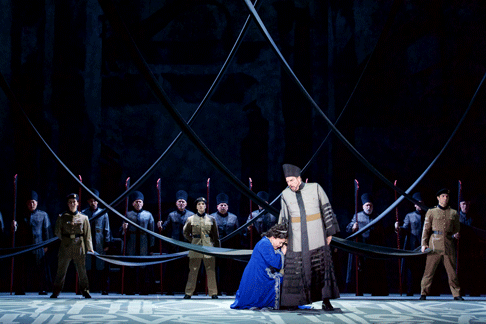 Elena Gabouri (Amneris) and Daniel Sumegi (Ramfis). [Photo by Jacob Lucas]
Elena Gabouri (Amneris) and Daniel Sumegi (Ramfis). [Photo by Jacob Lucas]
War and its agonies had been pretty much painted over, rendering Verdi’s stuffy but memorable opera as anodyne as a Midwestern Christian college musical: at the cost, granted, of depriving it of any dramatic impact at all.
That left us with half a dozen of Verdi’s most memorable tunes to occupy us for three and a half hours. We were diverted (or not) strictly to the extent the performers were capable of overcoming the incoherence of the staging and the faint but pervasive aroma of bad faith.
Most prepossessing of the Saturday evening cast I saw was David Pomeroy as Radamès. His voice is not particularly beautiful or powerful, but his stamina convinces one he could go on popping off ringing high As and Bs all night, and his youthful, open demeanor earns necessary sympathy for one of the most clueless heroes in the whole repertory.
Alfred Walker scored points for his dignity and dramatic declamation as the heroine’s prisoner father Amonasro. The same goes for bass Daniel Sumegi as the high priest Ramfis, towering over everybody else like the very incarnation of high dudgeon.
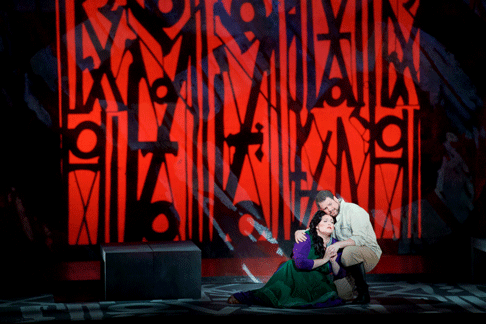 Alexandra LoBianco (Aida) and David Pomeroy (Radamès). [Photo by Jacob Lucas]
Alexandra LoBianco (Aida) and David Pomeroy (Radamès). [Photo by Jacob Lucas]
As the title character Alexandra Lobianco sang the tender music of acts three and four with sweetness and warmth; in the first two acts, she was inaudible whenever the orchestra rose above mezzo piano. Burdened with silent-movie heroine make-up and blocking which kept her hovering timidly on the edge of the action, she seemed feebleness personified. It seemed impossible that fierce divas like Leontyne Price and Birgit Nilsson could have achieved fame in such a mousy role.
No such doubt could be felt in Elena Gabouri’s Amneris, Aïda’s rival for the hero’s love. Amneris is a severly conflicted woman; Gabouri made her a thoroughly disagreeable one as well. Her first appearance, marching around Egyptian military HQ and blaring with bad temper, set the tone for her whole performance.
John Fiore appears to be a “singer’s friend” type of opera conductor, giving telegraphic cues and pacing generously, at the cost of dramatic tension Jessica Lang’s choreography, most prominent in the Triumphal scene, is pretty, graceful, and cloying.
“Cloy” doesn’t cover the substitution of a covey of red-beret-wearing Cub Scouts for the libretto’s dancing Moorish slave-boys. They also feature in the climax of the Triumphal scene, along with a blizzard of gilded-vinyl confetti. Cute kids and confetti: that’s what I’ll remember from this production. Whatever the political incorrectness of Verdi’s original, it didn’t deserve this.
Roger Downey
Cast and production information:
Ramfis: Daniel Sumegi; Radames: David Pomeroy; Amneris: Elena Gabouri; Aida: Alexandra Lobianco; King: Clayton Brainerd; Messenger: Eric Neuville; High Priestess: Marcy Stonikas; Amonasro: Alfred Walker; Stage Director: E. Lauren Meeker, after the original staging by Francesca Zambello; Set Design: Michael Yeargen; Projections hangings, set pieces: RETNA (Marquis Duriel Lewis); Costumes: Anita Yavich; Lighting Design: Mark McCullough and Peter W. Mitchell; Choreographer: Jessica Lang; Chorus Master: John Keene. Seattle Opera Orchestra, John Fiore, conductor.
image=http://www.operatoday.com/180502_Aida_DR.1_-1608.png image_description=Alexandra LoBianco (Aida). Jacob Lucas photo product=yes product_title=Aïda in Seattle: don’t mention the war! product_by=A review by Roger Downey product_id=Above: Alexandra LoBianco (Aida). [Photo by Jacob Lucas]May 20, 2018
Glyndebourne Festival Opera 2018 opens with Annilese Miskimmon's Madama Butterfly
Miskimmon has shifted the action forward to the 1950s in order, she explains, to use the ‘fake GI bride industry’ that was kick-started by the 1945 War Brides Act and the 1952 Immigration Act, which enabled American serviceman to bring foreign brides home to the US to underline the darkness of the power, to underline the exploitative darkness of the power dynamic between Lieutenant B.F. Pinkerton and Cio-Cio-San.
So, the action begins in the ugly office of Gozo’s ‘marriage-broker’ business - though the catalogues of oriental beauties from which the GI’s make their choice and the clanging chink of silver in the cash register suggests that ‘brothel’ might be a more apt term. Designer Nicky Shaw evokes a drab seediness: higgledy-piggledy filing cabinets are illuminated by the intermittent flash of red and blue neon - ‘Hotel’, ‘Tattoo’ - and as cheap confetti is strewn brusquely over the conveyor belt of brides, the strings’ violent stabs in the overture take on a discomforting resonance. Flip-charts spin and cine-reels roll, instructing Eastern ingénues how to be a good American wife and embark on a journey to a new life in the US, where they can live the Dream. There is a disturbing double displacement: the Americans have callously colonised Nagasaki, and then coerced and lured the Japanese into their own world. Nowhere is this more apparent than when Cio-Cio-San is forced by her new husband to fling her wedding bouquet over her shoulder, as confused as the wedding guests who dart aside to avoid its fall.
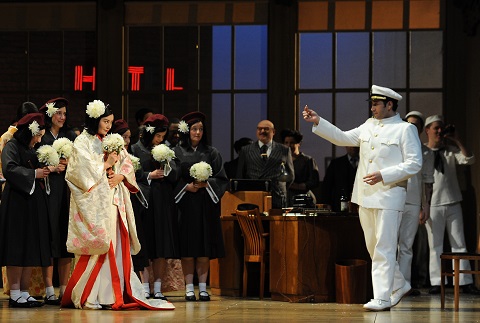 Olga Busuioc (Cio-Cio-San, left), Joshua Guerrero (Lieutenant B.F. Pinkerton, left), Carlo Bosi (Goro, rear). Photo credit: Robbie Jack.
Olga Busuioc (Cio-Cio-San, left), Joshua Guerrero (Lieutenant B.F. Pinkerton, left), Carlo Bosi (Goro, rear). Photo credit: Robbie Jack.
It leaves a horrid taste of merciless mercantilism, which makes Miskimmon’s point. More problematic is that the shift of locale makes a nonsense of the libretto’s frequent references to the house on which Pinkerton has just taken out a 999-year lease. An estate agent’s cardboard model is an attempt at remedy: and, the miniature abode does underline that paper walls can be shifted just as easily as deeds can be undone and knots tied torn asunder. It’s all a game - Pinkerton lounges insouciantly with his feet on Gozo’s desk - and Cio-Cio-San is a plaything, a doll. This ‘unreality’ is emphasised during the marriage ceremony by the division of the stage, as the bored US contingent lean impatiently, stage-left, while opposite, Cio-Cio-San’s family strive to earnestly engage in the ‘ceremony’.
The arrival of Oleg Budartaskiy’s dark-hued and threatening Bonze upsets the proceedings. When Pinkerton has angrily dismissed those who condemn his bride for betraying the gods of her ancestors, they are left alone to spend their wedding night in the broker’s office, and at this point one’s credulity is stretched. The cine-reels starts up, a visual accompaniment to their duet, but despite their words of love, the images of boats bearing joyfully waving Japanese brides past the Statue of Liberty are more reflective of Butterfly’s hopes than any intention on Pinkerton’s part. ‘Night is falling’ she sings, and the shop-blinds rise to give us a glimpse of golden stars blinking in the blackness, but the sentimentality is short-lived, and the gleam of celestial bodies is rapidly extinguished by the toxic glare of neon.
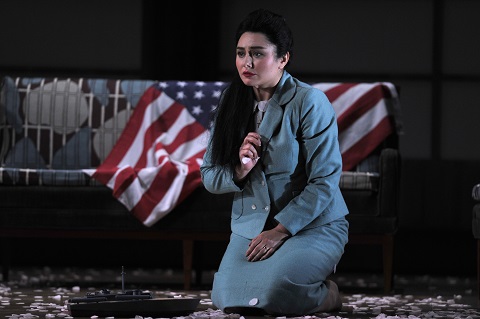 Olga Busuioc (Cio-Cio-San). Photo credit: Robbie Jack.
Olga Busuioc (Cio-Cio-San). Photo credit: Robbie Jack.
The discomforting tensions of colonial presence pervade Act 2 also, where Butterfly is found living in an ‘American house’: Pinkerton has left her the monthly rent, some chic upholstery, a television set and a Stars-and-Stripes, and so keen is Butterfly to impress upon visitors her all-American up-to-datedness, she dresses herself in the unflattering, green two-piece suit which was her husband’s inappropriate wedding gift, files her nails and powders face while watching the box, legs pertly crossed at the knee like any good American housewife. But, beyond the shōji screens the falling sakura blossom adds a note of wistfulness, evoking tears, the passing of time, and the star-dust of Butterfly’s dreams of Pinkerton’s return.
The strength of Cio-Cio-San’s fantasies is highlighted during the Act 3 intermezzo when, as she sleeps before her ‘husband’s imminent arrival, her dreams are writ large. At the start of Acts 1 and 2, the front-drop of aquamarine above dense crimson, slanting, slashing brush-strokes - evoking the Japanese sun, passion and blood - fades to ashen blackness; but in Act 3, some colour remains and through the filmy gauze Butterfly’s memory of being carried over the threshold between worlds by Pinkerton, into the room in which their son, Sorrow, was conceived, is enacted in a dream sequence. The moment is beautifully lit by Mark Jonathan, as night turns to day, making Pinkerton’s observations that the room is just the same, but filled now with cold desolation, all the more chilling.
Miskimmon’s intent to push her, not unreasonable, concept results in some non-sequiturs, and these are exacerbated by some questionable movement direction. In Act 1, when Butterfly impassionedly challenges Pinkerton about the fate of her lepidopteral namesakes in the US, why does he climb the library steps as he replies that the insect is pinned to ensure that it will not escape - he will hold her forever? Then, in Act 2, why does Simon Mechlinksi’s Prince Yamadori arrive in a jeep powered by the push-power of members of the US marine service, sheltered by be-suited girls wielding sun-coloured parasols?
There is some hammy acting, with a fair bit of swooning, arm-flapping and rushing about in anguish, anxiety or ardour. Sorrow, already lumbered with a depressing name-label, is his mother’s confessor and chief exhibit, and witness to her quasi-hysteria, violence - when Gozo spreads rumours about the boy’s parentage, she attacks him with her stiletto heel - and preparations for suicide. One would be surprised if there were not considerable psychological problems ahead, however kind and loving Ida Ränzlöv’s scarlet-suited Kate Pinkerton proves to be. But, the boy’s joy when he learns of his father’s return is neatly captured by young Rupert Wade: he is swept up in his mother’s and Suzuki’s optimism and relief, donning his father’s cap and circling the television set to practise his marching and naval salutes, as his mother gathers cherry blossom in the hammock of a US flag and sweeps it with profligate joy around the rooms of her American house.
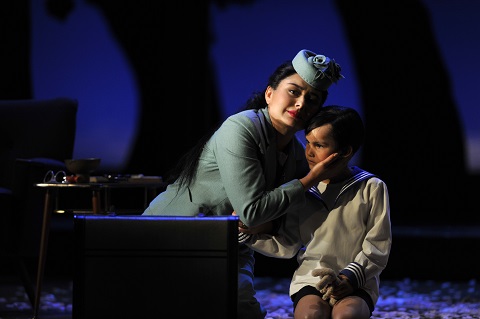 Olga Busuioc (Cio-Cio-San) and Rupert Wade (Sorrow). Photo credit: Robbie Jack.
Olga Busuioc (Cio-Cio-San) and Rupert Wade (Sorrow). Photo credit: Robbie Jack.
Olga Busuioc’s Cio-Cio-San is the towering vocal and emotional linch-pin of this production. There is a delicacy and cleanness about the Moldovan soprano’s sound that shines with the naivety of adolescence, but we quickly appreciate that there are emotional depths which are ripe for igniting - when she snatches back her father’s sword from the disrespectful Pinkerton, and when she sings of the souls of her ancestors. In ‘Un bel dì vedremo’ she sings directly to us, pulling us into her own dream: both Butterfly’s innocence and the clarity and directness of the vocal line compel us to believe in her hopes, and as the aria proceeds it is infused with ever greater richness and colour.
Joshua Guerrero’s Pinkerton makes less of an impression: musically he is ardent when required, but dramatically this Pinkerton is rather flimsy. Flippant and egotistical at first, he does seem disconcerted perhaps by his bride’s age and by the genuflecting hordes paying homage to Butterfly’s ‘lord’; when they are married he is startled by her fragility and purity, which doesn’t betoken emotional depth, and his final avowals of guilt and regret don’t carry much weight.
Carlo Bosi’s Gozo is a slimy piece of work, counting his takings in full glare of his dupes, and whipping out a photo-chain of alternative brides for the rejected Yamadori. Michael Sumuel is a humble, hesitant somewhat ineffectual - though vocally sensitive and shapely, Sharpless at first, slightly bewildered by the crossing of his own moral thresholds. But, he rises heatedly to vigorous anger when he reminds Pinkerton of his prophecy that nothing good would come of playing with honest, guileless trust and love.
The loudest applause of the night was reserved for Elizabeth DeShong’s Suzuki who so impressed in the role at the ROH last year; we were ever aware of DeShong’s presence, even when she was silent, and the slightest of vocal utterances intimated great strength of character, feeling and loyalty, qualities released by the expansive of her vocal contribution in the Act 2 flower duet and in her Act 3 exchanges with the Pinkertons where her mezzo-soprano plummeted with real pain.
Conductor Omer Meir Wellbeir focused on the murmuring melodic delicacy of the woodwind and harp and avoid the temptation towards melodramatic tastelessness. The off-stage choral humming was atmospheric, though the Glyndebourne Chorus were denied some of the expressive majesty of their entries by the set design and concept. The former also led to some muddled outside-inside wanderings in Acts 2 and 3: Butterfly’s ritual suicide takes place ‘outside’, which creates a distancing that persists when her son opens his present from his father and plays with a toy boat, oblivious to the fact that he mother is dying behind him, as Pinkerton’s cries, ‘Butterfly!’, float in to little emotional effect.
Fortunately, this production has Olga Busuioc to restore its dramatic, emotional and moral heart, and to ensure that the discomforting darkness does not lack a guiding light.
Madama Butterfly continues until 18th July. Further details are available at Glyndebourne Festival 2018 .
Claire Seymour
Puccini: Madama Butterfly
Cio-Cio-San - Olga Busuioc, Lieutenant B.F. Pinkerton - Joshua Guerrero, Goro - Carlo Bosi, Suzuki - Elizabeth DeShong, Sharpless - Michael Sumuel, Bonze - Oleg Burdartaskiy, Prince Yamadori - Simon Mechlinski, Sorrow - Rupert Wade, Kate Pinkerton - Ida Ränzlöv, The Cousin - Jennifer Witton, Cio-Cio-San’s mother - Eirlys Myfanwy Davies, Yakuside - Adam Marsden, The Aunt - Shuna Scott Sendall, Imperial Commissioner - Michael Mofidian, Official Registrar - Jake Muffett; director - Annalise Miskimmon, conductor - Omer Meir Wellber, designer - Nicky Shaw, lighting designer - Mark Jonathan, movement director - Kally Lloyd Jones, video designer - Ian William Galloway, London Philharmonic Orchestra, Glyndebourne Chorus.
Glyndebourne Festival Opera; Saturday 19th May 2018.
Image=http://www.operatoday.com/Cio-Cio-San%20%28Olga%20Busuioc%29.jpg image_description=Madama Butterfly, Glyndebourne Festival Opera 2018 product=yes product_title=Madama Butterfly, Glyndebourne Festival Opera 2018 product_by=A review by Claire Seymour product_id= Above: Olga Busuioc (Cio-Cio-San)Photo credit: Robbie Jack
May 16, 2018
Remembering Debussy
At the heart of the programme lay Claude Debussy’s Cinq Poèmes de Baudelaire (1889) and Jonathan Dove’s Letters from Claude. The latter was commissioned by the Richard Thomas Foundation at the invitation of pianist Andrew Matthews-Owen and premiered here by soprano Claire Booth and mezzo-soprano Susan Bickley.
Debussy was a prodigious letter-writer, and indeed a discerning and prolific writer, critic and journalist per se. Nine volumes of his correspondence were published between 1927 and 1958, and more than 1500 of his letters survive. Among his correspondents were three women whom he bound together in amorous knots, not of their will. Gabrielle Dupont was a professional mistress from the lower echelons of the grandes horizontales society of the 1890s; Debussy abandoned her for Rosalie (Lilly) Texier, whom he married in 1899 (pressuring her into wedlock by threatening suicide); she shot herself in the stomach when Debussy subsequently left her for one of his rich pupils, Emma Barduc, with whom he had his only child.
Jonathan Dove’s Letters from Claude, as the composer himself explains, takes text from sixteen of Debussy’s letters and fragments: ‘I imagine that, perhaps after Debussy’s death, Lilly and Emma just happen to be reading some of his letters in their different homes at the same moment. There memories are, of course, full of his music, and so the piano accompaniments are each prompted by a chord or phrase from piano pieces Debussy wrote around this time - Suite Bergamasque (1890-1905), and Estampes (1903) - along with the early Danse (1890).’
The fragments which form this 12-minute whole run segue, and there was an urgency as we moved from mezzo-soprano Susan Bickley’s recitation of the composer’s insouciant instruction to Lilly to ‘put on your pink petticoat and your black hat and [to] come and say hello to me next Sunday’ to his ardent avowal of passions ‘secretly burning’ and impatience for ‘your mouth, your body’, just three days later. The charm of the fragment in which the composer reflects on the ‘Lovely Lili’s’ whereabouts and movements - she is probably lending ‘the slender grace of her body to various gorgeous dresses’ - was embodied by a beautiful translucent piano accompaniment.
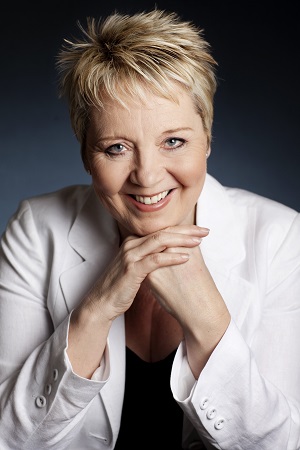 Susan Bickley. Photo credit: Julie Kim.
Susan Bickley. Photo credit: Julie Kim.
Soprano Claire Booth revisited Emma Bardac’s memories, the composer’s abstract images of fragrances and flowers finding shape in trickling piano figures, and his request that Lilly should pay him a visit, even though the rain falls heavily, characterised by a circular motif of pattering wetness.
Dove conveys the complexity of torn and tattered allegiances by overlapping the voices: this is evocative in a general way, though it inevitably obscures the texts, which were also sometimes lost to an overly loud - sounds of the ‘mechanism’ were occasionally intrusive - accompaniment from Matthews-Owen. For example, Bickley’s recount of Debussy’s letter to Lilly of 23rd May 1899 - ‘I love you, I love you … I can only think of your return, and of the three whole days which you will grant me. And such a delicious ache it gives me. God how I love you.’ - was overpowered by the piano’s growing animation. Dove’s settings also lack variety - perhaps suggestive of Debussy’s emotional limitations? - as he frequently relies upon ponderous, pounding bass notes, which often descend (à la Delius or Lloyd Webber), languorously, by step, above which ostinatos or fragments in the middle and upper registers float.
By contrast, the use of unaccompanied voices in some of the later fragments was effective and the directness of the homophonic utterances suggested shared experiences. But, given the wealth of text from which to choose, one wonders what Dove hoped to capture in such oblique fragments drawn from two letters to Emma, of June 1904: ‘Hello Madame Bardac?’ and ‘Yes…! Yes! Yes!’ That said, the climax of the closing episodes was well-shaped; recalling Debussy’s missive of 24th December 1916 to Emma, Booth made the carolling bells shine - ‘Noël! Noël!’ - and the ambience was sustained in the right-hand piano echoes above low pedals in the bass. Bickley’s cold declamation of Debussy’s rejection of Lilly, ‘I have to tell you that nothing on earth would compel me to meet up with people with whom I have broken off all relations’, fell low and lingered chillingly.
Booth’s performance of Debussy’s Cinq poèmes de Baudelaire, which preceded the interval, was less convincing. There was certainly passion and extase in the vocal line - a real gloss at the top, as at the close of ‘Le balcon’, with its images of countless vows, perfumes and kisses - as well as a contrasting coolness at times; and, Matthews-Owen negotiated the motivic and textural complexities of the piano-writing with accomplishment. But, Booth did not always control the contours immaculately - rising lines had a tendency to break off too abruptly - and the text was often indistinguishable; given that these songs embody the symbolists’ aesthetic and desire to blur the distinction between poetry and music, this was problematic.
The central song, ‘Le jet d’eau’, revealed Booth’s rich lower register, and here something of the tenor of the language and mélodie was struck. There was a strong sense of the waves of sensory experience offered by the bounding of the bold soul towards the ‘vast enchanted skies’, and of the trembling magic of the ‘Moon, sonorous water, blessed night’ which reflect the poet’s love. The piano’s rhythmic complexities in ‘Recueillement’ (Meditative calm) were stirring and Booth infused the narrow compass of the vocal line with life, the energy subdued but always present, culminating in a final melodic plunge which carried us downwards with the ‘step of the gentle Night’.
Five songs by Gabriel Fauré brought the best from the two singers. Booth’s rendition of ‘Clair de lune’ was fluent and fresh, and ‘Au bord de l’eau’ had a lovely, heady, rolling flow. The fairly brisk tempo of ‘Après un rêve’ ensured directness and eschewed indulgent sentimentality. Susan Bickley communicated powerfully in ‘Les rose d’Ispahan’, and there was a real sense of the hypnotic arc of each stanza, while Bickley’s beguiling lower register was put to good effect in ‘Nocturne’, which had a delicious murmuring quality conveying mystery, as the night ‘half opens its blue jewel caskets’.
Bickley and Matthews-Owen framed the recital with songs by Erik Satie. In the opening ‘Élégie’, Bickley made a good attempt to capture the distance which comes from loss - and Satie’s characteristic abstraction - but the descending scales of the song and the awkward intervallic contrasts which pit pure fifths/fourths against tritones, with little harmonic or textural support from piano, made this a difficult song with which to open the recital. But, while Bickley’s intonation took a little while to settle, there was a sensitive diminishment at the close, ‘Le seul remède sur la terre/À ma misère/Est de pleurer’ (The only remedy on Earth for my misery is to cry) slipping away like a falling tear.
The piano hopped with the jerky spring of a frog at start of ‘La statue de bronze’ and Bickley used the low lying declamatory passages to convey a wry wit. In contrast, ‘Daphénéo’ was tranquil, as the gentle vocal survey of just three or four notes established a stillness and lack of sentimentality.
While occasionally the low voice was lost amid the density of the piano’s pounding triplet quavers, Bickley enjoyed the deadpan parody (of Gounod) in ‘Le chapelier’ (The mad hatter), where the lunacy of the mad hatter’s attempts to fix his languid wristwatch - oiling it with butter, clogging the gears with bread-crumbs and plunging it in cups of tea - were all to no avail, consequence or import, as the Dada-esque throw-away conclusion confirmed.
The fun was resumed at the close in the sardonic sparseness of ‘Air du poète’ and the stylish insouciance of ‘Je te veux’ which took us from the salon to the cabaret. In between there were some ‘Vexations’ - fortunately only five of 840 that Satie ‘instructed’.
Claire Seymour
Claire Booth soprano
Susan Bickley mezzo-soprano
Andrew Matthews-Owen piano
Satie - ‘Elégie’ from Trois Melodies (1886); Trois Mélodies (1916)
Debussy - Cinq Poèmes de Baudelaire (1889)
Jonathan Dove - Letters to Claude, for soprano, mezzo-soprano
& piano (World premiere)
Fauré - ‘Clair de lune’ Op.46 No.2, ‘Au bord de eau’, Op.8 No.1, ‘Après un
rêve’ Op.17 No.1, ‘Les roses d’Ispahan Op.39 No.4, ‘Fleur jetée’ Op.39
No.2, ‘Nocturne’ Op.43 No.2
Satie - ‘Air du poète’, ‘Vexations’, ‘Je te veux’
Purcell Room, Southbank Centre, London; Tuesday 15th May 2018.
Image=http://www.operatoday.com/Claire-Booth%20Sven%20Arnstein.jpg image_description=Remembering Debussy: Claire Booth (soprano) and Susan Bickley (mezzo-soprano) at the Purcell Room product=yes product_title=Remembering Debussy: Claire Booth (soprano) and Susan Bickley (mezzo-soprano) at the Purcell Room product_by=A review by Claire Seymour product_id= Above: Claire BoothPhoto credit: Sven Arnstein
May 15, 2018
Garsington's Douglas Boyd on Strauss and Skating Rinks
So noted the New Yorker’s Alex Ross (in The Rest is Noise ), adding, ‘It is at once touching and unsettling to picture Strauss immersed in artifice of Capriccio in the early months of 1941 when German forces were gearing up for the invasion of Russia and Heydrich’s Einsatzgruppen were set to slaughter Jews and Slaves in their wake. Touching, because one can sense Strauss’s need to disappear into a realm of tones. Unsettling, because his work was so at odds with the surrounding reality’.
Garsington Opera’s Artistic Director, Douglas Boyd, would beg to differ. When we met this time last year , he was busy rehearsing for the revival John Cox’s production of Le nozze di Figaro which he himself was to conduct, but he was also eagerly looking ahead to the following year’s festival season which would bring the opportunity to conduct his first Strauss opera, Capriccio directed by Tim Albery - a co-production with Santa Fe Opera.
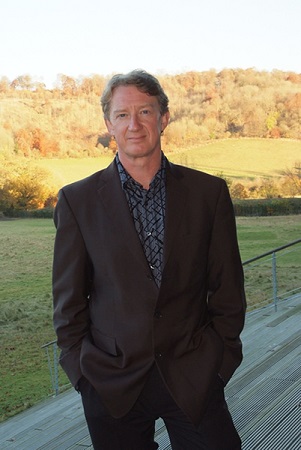 Douglas Boyd, Artistic Director of Garsington Opera.
Douglas Boyd, Artistic Director of Garsington Opera.
Rehearsals are now underway, and Boyd rejects the notion that Capriccio indicates Strauss’s ‘indifference’ to the world. I suggest that it’s an opera in which ‘nothing happens’: the the Countess Madeleine is asked to settle a dispute between her brother, the composer Flamand, the poet Olivier, and the theatrical impresario La Roche, over the relative status of music and words - and, after two-and-a-half hours of philosophy and art, she is no closer to making her mind up about aesthetic matters than she is to deciding upon the rival romantic merits of the poet and composer.
But, Boyd explains, Capriccio - the idea for which originated in Stefan Zweig’s research, in the British Library, into the controversy about Gluck’s reforms in the eighteenth century, and Zweig’s particular interest in Abbate Casti’s libretto for Pergolesi’s Prima la musica e poi la parole - is so much more than simply an addition to the canon of operas about opera. Far from being ‘apolitical’, Capriccio is Strauss’s response to a world which in 1942 seemed to be on the verge of apocalypse. The question that the opera asks - which is most important, words or music? - is far from trivial; rather, it is an assertion of essential human values at a time when humanity was tearing itself apart. When I note that James Sohre, reviewing Sante Fe’s 2016 production during the last US presidential campaign, had remarked that ‘with all the bombast […] rattling in our heads, with invectives being exchanged and measured discussion all but absent, how utterly lovely to retreat and relax into the harmonious soundscape and well-reasoned debate posed in Strauss’ Capriccio’, Boyd smiles: “Yes, ‘Words, or music?’ is not a question one can imagine Trump asking.” We need to ask ourselves, “What do Flamand, Olivier and La Roche symbolise or represent?”
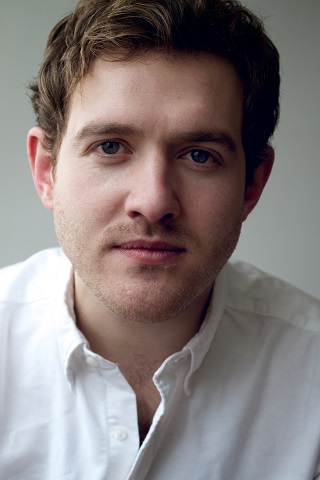 Sam Furness (Flamand).
Sam Furness (Flamand).
Built originally by founder John O. Crosby in 1957 on a former guest-ranch seven miles north of the city, with its panoramic views of the Jemez Mountains to the west and the Sangre de Cristo Mountains to the east, the Sante Fe Theatre - described by The New Yorker as ‘a miracle in the desert’ and, according to The Washington Post, a ‘shining white cloud in the red hills’ - may seem to have little in common with Robin Snell’s ‘floating’, kabuki-inspired Pavilion on the Getty family’s Wormsley Estate. But, as Boyd explains, both theatres are closely connected to their surrounding landscapes: at Sante Fe, the West-facing audience can witness the New Mexico landscape and sunsets which are visible when no backdrops are used; at Garsington, the setting and twilight so often become part of the performance. As I noted of last year’s production of Semele : ‘[Designer Nicky Shaw] presents us with a night-blue observatory panorama of pendulous orbs amid zodiacal light and nebulae. The splintered chandeliers are replaced by gleaming globes. It’s a hypnotically beautiful vista, and as the real night descends around the Garsington pavilion one can almost hear the cosmic harmony.’
Tobias Hoheisel’s set for this Capriccio was designed with both venues in mind. Director Tim Albery has transferred the opera from the late eighteenth-century to the years just after the opera’s composition, but the 1950s locale incorporates an echo of that earlier world and in so doing neatly sustains the meta-theatrical dimension of Strauss’s opera. Taking his cue from the migration of so many artists and intellectuals from Austria and Germany during the 1930s and ’40s, Albery has imagined a post-modern house whose aristocratic owner welcomes these emigres and provides a ‘refuge’ within which artistic relationships can be formed and creativity can be nurtured. Indulging her passion for all things eighteenth-century, the Countess has built a replica drawing-room in which the evening’s conversations, deliberations and entertainments unfold.
Boyd is relishing the new ‘discoveries’ which Strauss’s score continually affords, as he finds new ‘layers’ in the orchestration and explores the way the music meticulously and miraculously ‘paints’ the words and action on stage. The opera is essentially a conversation piece - we have to wait a long time for the final twenty minutes of glorious Straussian arioso, but it’s worth waiting for, adds Boyd - and one of the challenges is to ensure that the dialogue appears spontaneous and natural, as if it were a spoken play; it’s all in the score but it’s tricky balancing the rigour of rehearsed details with the freedom required in the execution.
I comment that the cast of Capriccio, indeed of all of Garsington’s 2018 productions, comprises a good balance of young and more experienced singers. Alongside Miah Persson’s Countess, Andrew Shore will sing La Roche and William Dazeley is the Count, while Gavan Ring as the poet Olivier will contest for the Countess’s love and preferment with Sam Furness’s composer, Flamand. Boyd aims to welcome strong, international casts who are committed to performing at Garsington - he’s not interested in ‘big names’ who are flown in because it looks good on the headed paper - and he warmly and strongly praises the invaluable contribution made by Garsington’s Director of Artistic Administration Laura Canning, in her work with production teams, principal singers, chorus and orchestras.
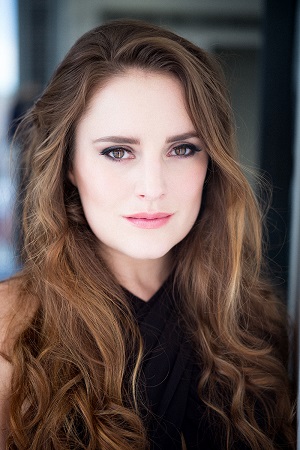 Louise Alder (Pamina).
Louise Alder (Pamina).
To my query whether co-productions will become a familiar feature of future Garsington seasons, Boyd comments that there may be further co-productions - there can of course be cost benefits - but that co-productions need to be mutually advantageous to both partners. He will return to Santa Fe in the autumn for discussions with Robert Meya, who will take up his post as SFO’s General Director in October, and Alexander Neef, recently installed as the company’s first Artistic Director, about possible future collaborations, but there are no definite plans.
In the meantime, there are three other new productions at Garsington this summer. To start the season, director/designer Netia Jones and conductor Cristian Curnyn make their Garsington debuts with Die Zauberflöte . Boyd has previously worked with Jones - she added visuals which reacted in ‘real-time’ to a performance of Verklärte Nacht by the Manchester Camerata in 2011, for example - and the marvellous light and transparency of the elevated Pavilion will surely inspire Jones’s visual imagination as she explores the magic and enchantment of Mozart’s singspiel. Two young singers return to Garsington in the principal roles: Cardiff Singer of the World prize-winner Louise Alder (Ilia,Idomeneo, 2016) and Jonathan McGovern (Pelléas, Pelléas et Mélisande, 2017) sing Pamina and Papageno, while tenor Benjamin Hulett makes his Garsington debut as Tamino.
Garsington is committed to developing engagement with opera among new audiences and this year The Magic Flute project will see vocal director Lea Cornthwaite and director Hazel Gould create a 30-minute piece based on The Magic Flute for Garsington’s Adult Company in partnership with the C&C Choir, a choir of residents from sheltered accommodation in North London run by C&C Housing. The piece will be performed on the main stage at Wormsley on 3rd August.
Mid-way through the season, Bruno Ravella returns to Garsington, along with designer Giles Cadle, following his esteemed 2015 production of Strauss’s Intermezzo to direct a new production of Verdi’s Falstaff which will be conducted by Richard Farnes, winner of the 2017 Royal Philharmonic Society Conductor of the Year Award. Henry Waddington is the eponymous knight, Mary Dunleavy and Richard Burkhard sing the roles of Alice Ford and her jealous, raging husband, while Victoria Simmonds and Soraya Mafi appear as Meg Page and Nannetta respectively.
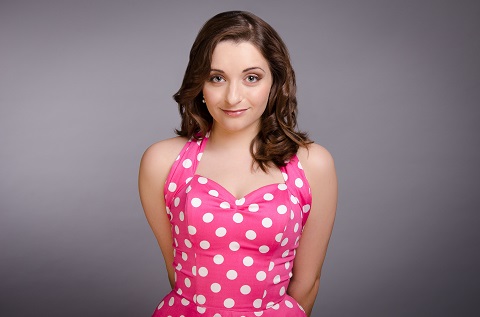 Soraya Mafi (Nannetta).
Soraya Mafi (Nannetta).
Boyd speaks energetically and with passion and commitment about all three above-mentioned operas, but it is the fourth of Garsington’s 2018 productions which seems to ignite his greatest zeal and intensity. The Skating Rink is a newly commissioned opera by British composer David Sawer, with a libretto - based on the short novel by Chilean author Roberto Bolaño - by award-winning playwright Rory Mullarkey. The story is gripping, blending murder, lust and corruption with a touch of the surreal. Obsessed with a beautiful young skating champion, Nuria, Enric determines to build her an ice-rink in a deserted mansion near a Spanish sea-side town, and resort to underhand means. An eclectic cast of characters encircle the voyeuristic Enric, and as he watches Nuria spin ever-faster arabesques, so the web tightens on his secrets. A recent play-through with the cover singers has stirred Boyd’s excitement and anticipation for this new opera, the music of which he says is just as mesmerising as the drama which it so perfectly paints.
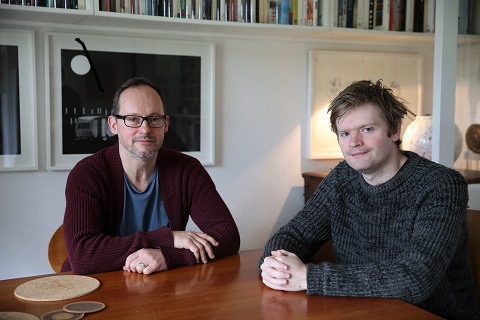 David Sawer, composer, and Rory Mullarkey, librettist.
David Sawer, composer, and Rory Mullarkey, librettist.
Garry Walker (The Cunning Little Vixen, 2014) returns to conduct The Skating Rink, with director and designer Stewart Laing making his Garsington debut. The first night will be the occasion of another debut, too: Garsington’s first world premiere. It is obviously enormously important to Boyd that we should have faith in modern-day composers and that while, undoubtedly, there are risks in commissioning new work, its essential that alongside superb productions of established work, Garsington enables the creation of new work for new audiences. “It’s the future, and it’s our legacy.”
Claire Seymour
image=http://www.operatoday.com/Skating%20Rink%20with%20auditorium.jpg
image_description=Garsington Opera, 2018: an interview with Artistic Director Douglas Boyd
product=yes
product_title=Garsington Opera, 2018: an interview with Artistic Director Douglas Boyd
product_by=By Claire Seymour
product_id= Above: The Garsington Pavilion
May 14, 2018
A chiaroscuro Orfeo from Iestyn Davies and La Nuova Musica
I struggle to think of a performance that might embody the spirit and practice of Gluck’s ‘reform’ aesthetic, as expressed in the composer’s 1767 Preface to Alceste, more pertinently and potently than Iestyn Davies’ rendition of ‘Che farò senza Euridice!’, as enjoyed during this performance of Gluck’s 1762 Orfeo ed Euridice at St John’s Smith Square with La Nuova Music - bringing to a close the opening weekend of the London Festival of the Baroque Music 2018 .
Beautifully direct and dignified, in ‘Che farò’ Davies’s powerful, penetrating but also patrician countertenor was imbued with a perfect balance of tonal purity and expressive colour. As from the Underworld Orfeo pleaded with the Heavens for answers to his dilemma - how to live without his beloved - Davies’ unearthly clarity evoked the supernatural and delicate, even while it rang so resonantly. I was reminded of Michael Tippett’s comment when he heard Alfred Deller sing for the first time, in 1944, that ‘felt the centuries roll back’. For there was timelessness and otherworldliness here.
So much depends upon the singer’s ability, in this oddly major-key aria, to elide love and loss, with the simultaneity of poetry, as joy and grief, present miseries and past memories, are inextricably fused and sung. In the Preface to Paride ed Elena (October 1770), responding to criticisms of the aria’s apparent jolly tonality and ambience, Gluck noted that, ‘Just the slightest change in the mode of expression is needed to turn my aria ‘Che farò senza Euridice’ into a dance for marionettes [ un saltarello di burattini]. One note held longer or shorter, a careless increase in tempo or the voice … may ruin a whole scene in a work like this.’ Davies was the epitome of effortless meticulousness.
From the first, the searing cries, plummeting an octave - ‘Euridice!’ - which puncture the opening chorus of mourning were heartrendingly unswerving - packing an emotional hit where it hurts. This voice cried out to be heard, by us and by the Gods. ‘Che puro ciel!’, sung in anticipation of Euridice’s resurrection and arrival, featured beautiful cadential ornamentation and trills, the perfect alliance of technique and expression. In ‘Chiamo il mio ben così’ Davies descended into a chest register with confidence and weight, enormously supplementing his characterisation of the role. And, while in these arias, the sheer beauty of Davies’ sound was entrancing, there was no lack of interest or striking impact in the lengthy recitatives - in fact there was even more engaging modulation of tone and phrase, fluidity of utterance, and naturalness of dramatic presence, as his countertenor rang and rippled with rapture, indignation and despair.
Fortunately, Orfeo’s partners in the drama, Euridice and Amore, were no less tellingly represented. Rebecca Bottone’s Amore was teasingly taut and bright in her initial recitative exchanges with the stuttering, questioning Orfeo, before Amore’s aria expressing faith in the fortitude of fidelity glistened thrillingly. Sophie Bevan sent rich ripples of sound cascading around the nave of St John’s, Smith Square; her shining expressivity warmed us to Euridice’s passion, disbelief and confusion. And, after so much solo singing, it was a delight to hear Davies and Bevan come together to assuage the preceding desolation in duets of delight.
The opera is formed from paradoxes: a musical representation of the love and loss from which opera sprang. And, as the setting sun shone into the shadows of St Johns, Bates ensured that the music spoke of peaks of both pleasure and pain. Characteristically animated, the conductor drew every hue from Gluck’s score - colourful brass and expressive oboe playing in the overture; a wonderfully paced interweaving of soothing harp and seething Furies in Act 2; a dulcet flute solo in the ‘Dance of the Blessed Spirits’ (the one number imported from the 1774 Paris score) which had not a drop of saccharinity; a beautiful airiness at the start of ‘Che puro ciel!’.
The Chorus produced a vibrant sound, by turns relaxed and wrought, warm with bright hopefulness and darkly Hadean; the higher voices seemed to dominate but this was countered by some lovely weightiness in the bass regions of the orchestra, resulting in buoyant, balance and blend.
The final Act 3 ballet sequence was piquantly characterised, the movements forming a compelling summary of discrete, individualised emotions as the pace swept onwards. In fact, Bates probably did not need to work so hard! He doesn’t conduct so much as gesticulate and ‘live’ the music - no bad thing! - but given the quality of responsiveness of his fellow musicians, perhaps not every musical gesture needs such emphatic physical re-enactment. That said, it was a joy to watch Bates’s delightful coaxing of uninhibited, extended thunder-blasts from the St John’s gallery!
If I had one small quibble, it would be to question why an interval was deemed necessary, breaking Act 2 - as Orfeo descended in hopefulness to the Underworld to rescue his beloved - after just 40 minutes.
Gluck’s Alceste Preface has asserted his belief that his opera ‘should achieve the same effect as lively colours and a well-balanced contrast of light and shade on a very correct and well-disposed painting, so animating the figures without altering their contours.’ And, this was indeed a ‘chiaroscuro’ Orfeo in which Bates, La Nuova Musica and the soloists, especially Davies, shone shafts of light which pierced the darkness, leading to the arresting and exultant illumination of the opera’s conclusion.
Claire Seymour
Gluck: Orfeo ed Euridice (Vienna edition, 1762)
Orfeo - Iestyn Davies, Sophie Bevan - Euridice, Amore - Rebecca Bottone; La Nuova Musica - David Bates (director)
St John’s, Smith Square, London; Sunday 13th May 2018
image=http://www.operatoday.com/iestyndavies%20Chris-Sorensen.jpg image_description=Gluck’s Orfeo ed Euridice, St John’s, Smith Square; London Festival of Baroque 2018 product=yes product_title=Gluck’s Orfeo ed Euridice, St John’s, Smith Square; London Festival of Baroque 2018 product_by=A review by Claire Seymour product_id= Above: Iestyn DaviesPhoto credit: Chris Sorensen
May 12, 2018
Lessons in Love and Violence: powerful musical utterances but perplexing dramatic motivations
It is shockingly exquisite. Following their archaeological investigations into the medieval past in Written on Skin, the pair have again delved into the historical archives: specifically, the chronicle of King Edward II’s obsessive and self-destructive infatuation with his French paramour, Piers Gaveston. Director Katie Mitchell meticulously and with microscopic focus show us how such love destroys the happiness of Edward’s wife, Isabella, and of his court and country. The resultant murders of the King’s lover, the King himself and, subsequently, his Machiavellian assassin, unroll with dreadful inevitability, before the ascension of his son restores ‘order’ to a riven realm.
Benjamin’s orchestral writing is characteristically but still astonishingly refined and precise. Bass-centred and hollow sonorities dominate: the echoing eeriness of resonant woodwind, suffused with pain and panic; the disconcerting strangeness of percussive twangs and bangs; harp-drumming that makes one’s nerves jangle. A prevailing low register characterises the vocal writing too, aiding textual clarity: the declamatory lines are masterfully delivered by the cast (there is not really anything that might be termed ‘melody’), and when I say I could hear every word, I mean it. Benjamin has been ably served by Crimp, who knows when to provide elongated vowels or a telling rhetorical-poetical utterance that can be musically memorialised. But, Benjamin must take double credit for such textual clarity, as discerning and judicious an orchestrator - like a painter he has surveyed a vast palette and selected just a few eclectic hues to unimaginably emotive effect - as he is orchestral ‘front-man’ with a baton in his hand.
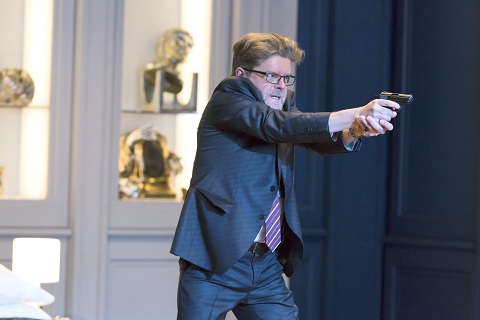 Peter Hoare (Mortimer). Photo credit: Stephen Cummiskey.
Peter Hoare (Mortimer). Photo credit: Stephen Cummiskey.
Both human morals and musical hues sink low, which only serves to emphasise the glistening lustre of Barbara Hannigan who, as Isabel, soars with stunning sumptuousness and sheen. Similarly, the high-lying lucidness of tenor Samuel Boden Boy/Young King evinces a penetrative purity and vision which is woefully absent elsewhere in this poisonous court. Stéphane Degout’s ‘King’ (no identifier is given) is paradoxically eloquent and petulant, his faith in his ‘divine right’ imbuing his proclamations of centrality and invincibility with seemingly impenetrable power. Gyula Orendt sings with honeyed slickness as the quasi-abusive Gaveston. And, as Mortimer, Peter Hoare almost out-sings all, willing us to side with his ‘rational’ vision of patriotic equilibrium.
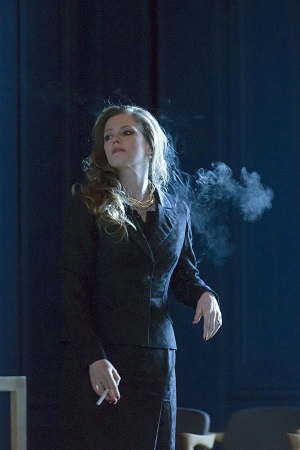 Barbara Hannigan (Isabel). Photo credit: Stephen Cummiskey.
Barbara Hannigan (Isabel). Photo credit: Stephen Cummiskey.
As the opera’s seven scenes unfold, Edward’s children - Boden’s ‘Boy’ and Ocean Barrington-Cook’s mute but expressive ‘Girl’ - watch all, ring-side spectators at a rivetingly horrific spectacle. And, we too are voyeurs, as Vicki Mortimer’s pristine, princely but clinical King’s Bedroom swivels to afford us a view from each of its four sides. Though Benjamin and Crimp eschew the third-person fussiness of Written on Skin - where characters announce their own words, ‘The Boy says …’ - Mitchell’s use of perspective creates a certain distancing, as from our bird’s-eye eyrie we watch this rancid world rotate, prey to our appetite for dissection and scrutiny.
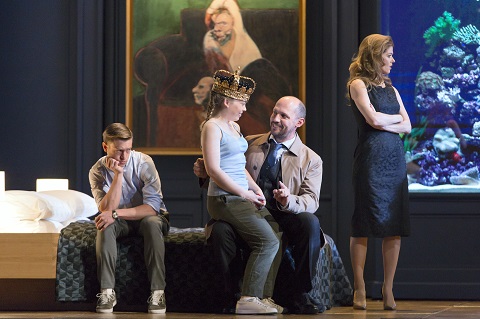 Photo credit: Stephen Cummiskey.
Photo credit: Stephen Cummiskey.
There is nothing ‘medieval’ about the set, and at a time when the whims and egos of those in power plunge us ever deeper towards apocalyptic abyss, that seems fitting. One wall of the King’s bedchamber sports an imitation of an artwork by Francis Bacon, the artist who put pain into painting with works that foregrounded, savagery, agony and mortality. On another, there is a fish-tank, initially pulsing with aquamarine and emerald currents but drained of colour, to barren ash, following the murder of Gaveston. A show-case of gilt busts, statuary and artefacts attests to the luxurious licence that wealth brings, and which Isabella rubs in the faces of the populace in the second scene of the opera when she responds to their pleas of poverty and suffering by, à la Cleopatra, dissolving a pearl in wine. Nothing shines brighter than the crown, golden and glowing in its glass presentation box.
With such glory on show, why did I leave the Royal Opera House feeling a little dissatisfied? Movement director Joseph Alford frequently uses a quasi-digital slow motion which is entrancing, as it suspends time, but also diverting, for this distancing device seems to me to encapsulate one of the opera’s ‘problems’: there is no dramatic conflict, by which I mean there are no developing characters, evolving relationships, changing allegiances, and knotty issues to be explored, unravelled and resolved. The greatest ‘drama’ occurs in the instrumental interludes between scenes where the music introduces conversing voices in ways absent in the sung scenes. Essentially, we are introduced to a nasty bunch of characters at the start of the opera, and their nasty end is a forgone conclusion. It is beautifully depicted, in music and visually, but it is not ‘dramatic’.
Crimp describes the opera as a ‘slightly oblique examination’ of Christopher Marlowe’s play, Edward II, but there are echoes of the latter which, when displaced from their original context, lose their rationale. Crimp explains that what is really striking in Marlowe is that ‘at the heart of it there is a man who dies for and of love’, and that this inspired the first line of his libretto: ‘It’s nothing to do with loving a man, it’s love full stop that is poison.’ To this end, he borrows one of Marlowe’s most potent lines: when Marlowe’s Mortimer Junior asks, ‘Why should you love him whom the world hates so?’, Edward replies, ‘Because he loves me more than all the world.’ At this moment, the King’s honesty and guilelessness compel us to side with him. But, such empathy is significant because in the play our sympathies fluctuate. And, at this point Edward expresses, so simply, our human need for affection. Elsewhere he is deluded, irresponsible and destructive, but Edward’s final soliloquy when, with weary despair, he futilely yearns for a moment of comfort among his friends and poetically anguishes over the torments he has endured, pushes aside the empty bombast that has preceded; here, at last, Edward possesses an eloquence worthy of his divine right to rule. In the opera, there is no comparable variety or dialectic in the King’s musical utterances, and so the expression of love loses impact and dramatic relevance.
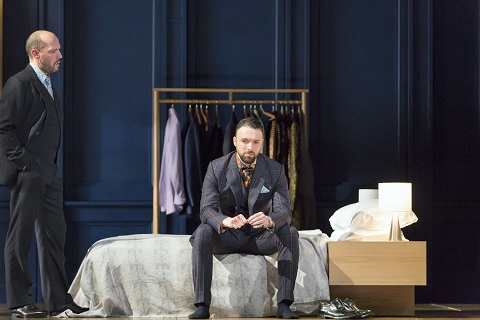 Stéphane Degout (King) and Gyula Orendt (Gaveston). Photo credit: Stephen Cummiskey.
Stéphane Degout (King) and Gyula Orendt (Gaveston). Photo credit: Stephen Cummiskey.
In the opera, Mortimer’s hateful vindictiveness towards Gaveston also lacks the sort of context that might introduce elements of ambiguity and play with our sympathies. In the play, the barons dismiss Galveston as a ‘night-grown mushrump’, but the Frenchman has a courtly sophistication which rebuts their coarseness; but in the opera Galveston is a quasi-abusive manipulator, and it is appropriate that Orendt returns as the controlling and heartless ‘Stranger’ - perhaps an echo of Marlowe’s Lightborn, an amoral mechanical murder-machine.
Marlowe was not interested in the ‘common man’; he ignored Holinshed’s account of Scottish plundering and a populace suffering from famine - possible motivation for the barons’ commitment to defence of the realm through dethronement or regicide - and focused on their personal, snobbish pique at Gaveston’s ‘common’ origins (not historically accurate). Such petty superiority makes us side with Edward for all his childish boorishness. But, in the opera there are no barons excepting Mortimer, and the populace is a shadow of grey suits bearing clip-boards. Where are the conflicting arguments that should test our sympathies?
The characterisation of Mortimer is equally problematic. Crimp retains Gaveston’s malicious inferences about Mortimer’s intent - he is a ‘snout’ poking up Isabel’s skirt - but Mortimer has to bear the weight of the court’s and country’s ‘reason’. Yet, rather than sliding from coherent patriotic arguments into impetuous self-aggrandisement, this Mortimer is a Machiavellian manipulator from the start. That said, while the execution of Mortimer at the end of Marlowe’s play, following so swiftly upon the murderer’s heroic avowals of unassailability and immunity, is dramatically necessary and satisfying, Crimp’s imagined scenario for Mortimer’s hubristic undoing is perhaps an even more pointed and painful outcome of his self-deluded profession of invulnerability: ‘ Maior sum quam cui possit fortuna nocere.’ (I am so great that Fortune cannot harm me)
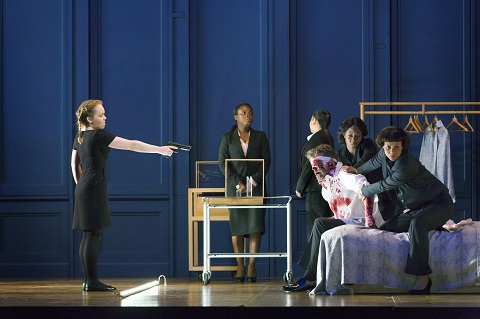 Ocean Barrington-Cook (Girl) and Peter Hoare (Mortimer). Photo credit: Stephen Cummiskey.
Ocean Barrington-Cook (Girl) and Peter Hoare (Mortimer). Photo credit: Stephen Cummiskey.
Crimp’s Isabel, too, seems lacking in psychological and emotional ‘layers’. When rejected by the King she dotes upon Mortimer, and we have a strong sense of his power over her, but the dramatic potency of the re-direction of the Queen’s affections relies on us believing in the veracity of her passion for husband in the first place, and the strength of her self-delusion that she can regain her husband’s love. Crimp and Benjamin show us Isabel’s delight in luxury, but not the strength of her marital love. In contrast, Marlowe’s Isabella rejects the jewels with which Edward bestows her as a reward for convincing the barons to agree to Gaveston’s return from exile, and pleads instead for ‘a kiss’ to revive ‘poor Isabel’.
The opera’s seven scenes do not unfold with the logic of a lesson-plan; rather they are power-point images which illustrate isolated stages on the protagonists’ journey to pain and purgatory. There is no interrogation of what love ‘is’, why human beings tolerate and execute violence, or how love and violence come to be so inextricably bound. At the close, the Boy/Young King has learned only the art of imitation: how to inflict cruelty, and to argue that the execution of inhuman brutality is in the name of justice and greater good. Has he learned self-awareness? How to love?
Lessons in Love and Violence is musically captivating, but dramatically perplexing.
Claire Seymour
George Benjamin:
Lessons in Love and Violence
Libretto: Martin Crimp
A co-production with Dutch National Opera, Hamburg State Opera, Opéra de Lyon, Lyric Opera of Chicago, Gran Teatre del Liceu, Barcelona, and Teatro Real, Madrid.
King - Stéphane Degout, Isabel - Barbara Hannigan, Gaveston/Stranger - Gyula Orendt, Mortimer - Peter Hoare, Boy/Young King - Samuel Boden, Girl - Ocean Barrington-Cook, Witness 1/Singer 1/Woman 1 - Jennifer France, Witness 2/Singer 2/Woman 2 - Krisztina Szabó, Witness 3/Madman - Andri Björn Róbertsson; Director - Katie Mitchell, Conductor - George Benjamin, Designer - Vicki Mortimer, Lighting designer - James Farncombe, Movement director - Joseph Alford, Orchestra of the Royal Opera House.
Royal Opera House, Covent Garden, London; 10th May 2018.
image=http://www.operatoday.com/Murder%20of%20Madman%20Photo%20by%20Stephen%20Cummiskey.jpg image_description=Lessons in Love and Violence, Royal Opera House, London product=yes product_title=Lessons in Love and Violence, Royal Opera House, London product_by=A review by Claire Seymour product_id= Above: The murder of the ‘Madman’, production imagePhoto credit: Stephen Cummiskey
May 9, 2018
Grands motets de Lalande
Since the theme of this year's London Baroque Festival is Treasures from Le grand Siècle their concert will naturally include music from the court of Louis XIV, such as Lully and Charles Tessier, but with typical Le Poème Harmonique flair will focus on the French fascination with turqueries, works evoking Turkey, Arabia, China and beyond. The origins of Orientalism, which would bear fruit with Rameau Les Indes Galantes and much more.
This new recording, however, focuses on music Lalande wrote for the Chapelle Royale at Versailles, where he officiated for more than 40 years, producing 77 grands motets for the Messe du Roi. Since the monarch was Louis XIV, religious ceremonies glorified not only God but his temporal French equivalent, a consideration to take into account given the relationship between the Papacy and the French court. On this recording Vincent Dumestre and Le Poème Harmonique present three of these grands motets, Deitatis Majestate, Ecce nunc benedicte and a Te Deum.
The earliest of these, Dietatis Majestate, dates from 1681 before Lalande took up his posts at Court. As Thomas Leconte writes, it "unfolds in a single majestic sweep from a succession of récits mostly for vocal trio or quartet, and grand choral sections regularly punctuated by instrumental interludes". Ecce nunc Benedicte (1683) is a setting of Psalm 133 and may have been used on feast days. It is "at once grave and festive". Vocal ensembles alternate with elaborate choruses. At its heart is a récit, "in noctibus extollite", where the soloists, are shadowed by an instrumental récit, high voices entwining against a backdrop of low timbres (bassoon, low-pitched winds and strings). The Te Deum was performed and revised many times, becoming a regular repertoire for Le Consort Spirituel, created to provide Paris with music during Lent when non-religious music was proscribed. The version used here is based on an early manuscript, retaining various revisions made over time, enabling modern performers to understand the evolution of performance practice. It is an impressive piece , each short section flowing elegantly into the next. "Tu Rex gloriae, Christe", the organ singing along with the voices. But the last lines "Et rege eos et extolle illos unique in aeternum" could apply to,other potentates as well, and are set with suitably glorious flourish. Le Poème Harmonique and Vincent Dumestre are joined by soloists Emmanuelle de Negri, Dagmar Šašková, Sean Clayton, Cyril Auvity and Andre Morsch with Ensemble Aedes (led by Mathieu Romano). .
Anne Ozorio
image=http://www.operatoday.com/3760014199684.jpg
image_description=Alpha Classics 968
product=yes
product_title=Majesté : Lalande, Grands motets pour le Roi-Soliel, Le Poème Harmonique , Vincent Dumestre,Ensemble Aedes
product_by=A review by Anne Ozorio
product_id=Alpha Classics 968 [CD]
price=$18.99
product_url=https://www.amazon.com/Lalande-Majeste-Ensemble-Aedes/dp/B07B6MHJL8/ref=as_sl_pc_tf_til?tag=operatoday-20&linkCode=w00&linkId=75913bc5e0da3d173b6d8b68042b6342&creativeASIN=B07B6MHJL8
Perpetual Night - Early English Baroque, Ensemble Correspondances
Though the songs are in the English language, they are in artistic terms very much attuned to wider European influences. In 1610, King James's son Henry became Prince of Wales, importing into his household musicians who favoured the "new music" of the era. Many were singer-lutenists, who could be deployed into flexible ensembles with other instruments, like the then-new theorbo providing continuo. Among the other new forms introduced was what is now called declamatory song. As Peter Holman writes in his notes these have the "character of a grace almand, or air, the vocal line mirrors speech inflections, and often illustrates words with appropriate images, so they are rarely tuneful though they tend to have more melodic coherence than true recitative".
Although Prince Henry died only two years later, the innovations he favoured took root, and were further developed by Charles, who was to become King Charles I. .Robert Johnson's Care-charming sleep was written for a play by John Fletcher, performed by the King's Men (Shakespeare's company). making the connection between Jacobean poet/playwrights and music, which would later flourish in the Restoration. John Corpario (1570-1620) was born John Cooper, adopting an Italianate name in line with the fashion of the time. He also served the next Prince of Wales, Charles, who was later to become King Charles I. His Go Happy Man is a song for high voice and lute, where the vocal line stands clear, the poetic purity of the vocal line revealed through intonation and phrasing. What tears dear Prince, can serve, by Robert Ramsey (c1590-1645) is a song of mourning, but so beautiful that it may well express personal sorrow. In contrast, Ramsey's Howl not, you ghosts and fairies is a miniature drama, illustrating a scene from Orpheus and Euridice for multiple voices including bass and a possibly allegorical extra character. Like Britanocles the great and good appears (William Lawes 1602-1645), it is an early example of a genre which would later become popular. Rise, princely shepherd (John Hilton 1599-1657) is a setting of The Judgement of Paris. In Lawes's Music, thy master of art, is dead, the interplay between different voices is pure polyphony. This emphasis on the beauty of vocal line elevates intonation and phrasing, employing voices as if they were instruments. In Adieu to the pleasures (James Hart 1647-1718) the instrumental introduction and postludes are more prominent, setting a context for the largely unaccompanied voice, and in Sarabande (Matthew Locke 1621/3- 1677), for variety, the instruments are unaccompanied by human voice, a rather appropriate prelude to When Orpheus Sang (Henry Purcell). Poor Celadon, he sighs in vain (John Blow) the flow of the voice, with clipped consonants and plangent, stretched vowels evokes the "English tenor" aesthetic. John Blow's cheery Epilogue: Sing, Sing,Ye Muses brings this delightful recording to a logical conclusion.
Superlative performances from Ensemble Correspondances with lithe, agile voices, especially the higher voices, male and female, complemented by Lucile Richardot. Her range is impressive, enhancing and integrating the other voices. At St George's, Hanover Square, on Wednesday 16th May, she will be doing a Hommage to Lully concert as part of the St John’s Smith Square London Festival of Baroque Music. The theme of the 2018 Festival is The Treasures of the Grand Siècle, curated by Sébastien Daucé and Ensemble Correspondances, and is exceptional, bringing many of the finest baroque specialists to London in an eclectic and very unusual programme of French music. This will culminate with their Le Concert Royale de la Nuit on 19th May. The recording is available on Harmonia Mundi and possibly soon on DVD (with dancing). Le Concert Royale marks the beginning of "modern" music, opera and ballet. It is also a metaphor for the baroque spirit, where audacity fuels extravagant imagination, elegance restraining excess, technical achievement balanced by refinement, agility and energy.
Anne Ozorio
image=
image_description=
product=yes
product_title=Perpetual Night : 17th century Ayres and Songs, Lucile Riuchardot, Ensemble Coirespondances, Sébastiuen Daucé. Harmonia Mundi HMM902269.
product_by=A review by Anne Ozorio
product_id=Harmonia Mundi HMM902269.
price=
product_url=
May 7, 2018
Les Salons de Pauline Viardot: Sabine Devieilhe at Wigmore Hall
It was a pity that the uncharacteristically tropical temperatures which have blessed this holiday weekend probably meant that fewer lovers of lieder grasped the opportunity to enjoy what was a discerning and elegant recital - as the sunshine took precedence over ‘la salon’.
I first encountered Devieilhe - whose initial studies focused on the cello and musicology - when reviewing the DVD of Krzysztof Warlikowski’s production of Handel’s Il trionfo del Tempo e del Disinganno at Aix-en-Provence in 2016, in which Devieilhe took the role of Bellazza. I wrote that she ‘dazzles in Handel’s glittering cascades, uses ornamentation with exquisite expressiveness, and displays an astonishing agility, leaping cleanly to the stratosphere and back with startling ease. At times, Deveilhe is surprisingly fierce, snarling through the upward appoggiaturas, flashing sparks at the top, but in the Part 2 aria in which she comes to her fate-sealing decision to spurn Piacere she exhibits a paradoxical and touching combination of emotional fragility and sincerity which conveys through impressive strength of tone and control of line.’
Not surprisingly, I excitedly anticipated her arrival on the Covent Garden stage as the Queen of the Night in the sixth revival of David McVicar’s 2003 Die Zauberflöte last autumn, and I was not disappointed. This recital was similarly characterised by a balance of composure and intensity, by vocal purity and precision and impassioned expression, with a sustained sensitivity to text. To put it in a way which may seem facile, Devieihle’s gleaming soprano is beguilingly easy to listen to … but the ways in which it seduces those susceptible to vocal beauty are diverse, inventive and masterful. I was also enormously impressed by the lucidity and sensitivity of Anne Le Bozec’s invaluable contribution to an aesthetic which accommodated frissons of colour and fervency with a prevailing self-possession and control.
Daughter of the Spanish tenor Manuel García, sister of esteemed mezzo-soprano Maria Malibran and of baritone Manuel García junior, who is credited with the invention of the first laryngoscope, Pauline Viardot was a leading social and artistic figure of her day: a talented pianist and composer, celebrated singer and mistress of a salon to which venerable artists such as Berlioz and Bizet, Liszt and Rubinstein, as well as new kids on the block including Debussy and Reynaldo Hahn, flocked. After her farewell performance in Paris in April 1863, Pauline and her husband Louis Viardot settled in Baden-Baden, and it was here that she initiated the salon that would attract musicians, composers, artists and writers from across Europe.
Devieilhe’s first sequence of songs focused on the French connection, and she and Le Bozec needed no time to get into their stride. The piano introduction to Berlioz’s ‘Villanelle’ from Les nuits d’ été (1840) was deliciously cogent and clear - lightly articulated quavers were supported by an eloquent bass line, creating a cleansing freshness as the new season drives away the cold winter and the lovers enter the wood to gather lillies-of-the-valley - while Devieilhe’s youthful sweetness acquired frissons of incipient passion as the vocal line rose and fell. The predominant sentiment was one of carefree confidence and burgeoning, yet contained, ardour. The narrative simplicity of La mort d’Ophélie (1848) was immensely touching, against which Le Bozec provided emotional complexity and anguish, blooming richly into the third stanza’s account of Ophelia’s drowning. Dialectical motifs in the piano conveyed the airy ballooning of the young girl’s attire and the eddying force of the water that supports her, as Devieilhe’s increased vocal intensity wrung notes of anguish from Ophelia’s dying song. The close - as Ophelia’s dress dragged her down to the depths - was poignant, infused with sweetness and sadness.
Two songs by Bizet offered character and colour. ‘Pastoral’ (1868) was tenderly bucolic: the gentle siciliano lilt carried us with ‘Colin’ through the valley as he sang to his shepherdess, and Devieihle’s pertly confident replies to his wooing acquired a mischievous esprit. A touch of the ‘exotic’ tinged ‘Adieux de l’hôtesse arabe’ (1866): Le Bozec injected judicious sensuousness into her pulsing, repeating rhythm, avoiding wry parody, while Devieilhe saved the sultriness to the end as the daughter of the desert’s exhortation to the ‘handsome young white traveller’ rang with lingering fervency: ‘Hélas! Adieu! bel étranger! Souviens-toi!’ (Alas! Farewell, fair stranger! Remember!)
Camille Saint-Saëns had a lifelong friendship with Viardot, and it was he who introduced Gabriel Fauré to the Viardot salon in 1872: the latter was later briefly engaged to Pauline’s daughter Marianne and dedicated many songs to members of the family. We heard Fauré’s ‘Au bord de l’eau’, in which the duo created an entrancing lapping lilt to convey the flow of the stream and gliding clouds on the horizon.
The central sequence of songs turned to Germany. I cannot imagine a rendition of Clara Schumann’s ‘Ich stand in dunkeln Träunen’ (I stood in dark dreams) imbued with more simplicity and loveliness. Devieilhe captured the stillness and the stirrings of the rapt moment of reflection, while Le Bozec’s enrichening of the accompaniment conjured the deceptive animation of the portrait which springs mysteriously to life at the end of the first stanza. The final declaration, ‘ich kann nicht’s glauben,/ Dass ich dich verloren hab!’, was an utterly sincere and direct expression of grief: wonderfully but woefully captivating.
I am more used to hearing Robert Schumann’s Myrten Op.25 sung by a tenor voice, but Devieilhe lent a certain purity to the soaring lines depicting the image of the beloved as the ‘heaven … in which I float’ (Mein Himmel du, darein ich schwebe) which was immensely touching. And, if the soprano struggled a little to project some of the lower lying lines here and in the ensuing ‘Der Nussbaum’ (The walnut tree), then the tone was always clean, and the diction excellent. Mendelssohn’s ‘Neue Liebe’ shone with the thrill of wild nights and danger when, in a moonlit wood, sightings of ‘elves’ and forest fairies promise bliss, or death. Le Bozec scurried nimbly, à la Midsummer Night’s Dream, while in the first two stanzas Devieihle blossomed gloriously from intimation to imagined consummation. A momentary halting, in a fearful realisation of the abyss, was pushed aside by a winning brazen confidence at the close.
The final songs carried us to the end of the nineteenth century. Le Bozec’s accompaniment was laden with the aromatic scents and soul of Debussy’s ‘Romance’, as embodied by the ‘divine lilies’ gathered from the garden of a lover’s thoughts, while Devieilhe’s almost fairy-tale purity made me long to hear her sing the role of Mélisande. Reynaldo Hahn’s ‘Le printemps’ sparkled with freshness and happiness.
We were also treated to two songs by Viardot herself; she composed over 200 songs, made admired vocal arrangements of Chopin’s mazurkas, and produced a number of chamber works including a lovely salon operetta, Cinderella. That Viardot, in addition to her vocal talents, was both a fine accompanist, had a talent for musical characterisation and a sense of fun was evident in ‘Haï luli!’ (Willow-waly), the gentle minor-key complaint of anxious waiting giving way to the warmth of consoling self-reassurance as Devieilhe let phrase endings hover and linger with exquisite skill and judgement. Turbulence ensued, with fears of fickleness, and in this song the highs and lows of love and loneliness were superbly plundered by both Viardot and her interpreters. In contrast, ‘Aime-moi’ was replete with confident teasing.
My only small regret was that this was rather a short recital. With the sequence of songs over in less than 45 minutes, the audience’s vociferous appreciation drew a welcome encore - Debussy’s ‘Apparation’, a setting of Mallarmé, in which Devieihle’s soprano soared with crystalline lustre.
But, we wanted more! Viardot made a memorable impact on the composers and artists of her day; she was a singer of remarkable vocal, musical and dramatic range and depth, qualities to which Devieihle can rightly aspire.
This recital was broadcast live on BBC Radio 3.
Claire Seymour
Sabine Devieilhe (soprano), Anne Le Bozec (piano)
Berlioz - ‘Villanelle’ from Les nuits d’été; Pauline Viardot - ‘Hai luli!’; Bizet - ‘Pastorale’ Op.21 No.9; Fauré - ‘Au bord de l’eau’ Op.8 No.1; Berlioz - La mort d’Ophélie; Bizet - ‘Adieux de l’hôtesse arabe’ Op. 21 No.4; Clara Schumann - ‘Ich stand in dunklen Träumen’ Op.13 No.1; Schumann - Myrthen Op.25 (No.1 ‘Widmung’, No.3 ‘Der Nussbaum’); Mendelssohn - ‘Neue Liebe’ Op.19a No.4; Pauline Viardot - ‘Aime-moi’; Debussy - ‘Romance’; Hahn - ‘Le printemps’
Wigmore Hall, London; Monday 7th May 2018
image=http://www.operatoday.com/Sabine%20Devieilhe%20Molina%20Visual.jpg image_description=Les Salons de Pauline Viardot Sabine Devieilhe (soprano) and Anne Le Bozec (piano) at Wigmore Hall product=yes product_title=Les Salons de Pauline Viardot Sabine Devieilhe (soprano) and Anne Le Bozec (piano) at Wigmore Hall product_by=A review by Claire Seymour product_id= Above: Sabine DevieilheMolina Visual
May 3, 2018
Jesus Christ Superstar at Lyric Opera of Chicago
For Lyric Opera’s production the principal roles of Jesus, Judas, Mary, Caiaphas, Annas, Simon Zealotes, Pilate, Peter, and Herod are sung by Heath Saunders, Ryan Shaw, Jo Lampert, Calvin Cornwall, Joseph Anthony Byrd, Mykal Kilgore, Michael Cunio, Andrew Mueller, and Shaun Fleming. The performances are conducted by Tom Deering and directed by Timothy Sheader. Sets and costumes are designed by Tom Scutt with lighting and sound design by Lee Curran and Nick Lidster. Choreography is under the direction of Drew McOnie. The Chorus is prepared by Lyric Opera of Chicago’s Chorus Master Michael Black.
The essence of the New Testament story, as evoked in the Rice / Lloyd Webber version by both music and text, is supported in this production by strong vocal and dramatic performances. Tensions existing over perceptions of Christ are emphasized from the start. The crowds of adherents stream down the theater’s aisles near the start of this production, when they surround and kneel before the central figure. This adulation is questioned immediately in Mr. Shaw’s first solo, “Heaven on Their Minds,” which summarizes effectively the recent differences noted by Judas as “your right hand man.” The familiarity and struggles captured by Ryan’s dramatic portrayal signal, at once, admiration and resentment. The apostles chorus, “What’s the Buzz,” has here the effect of a zealous inquiry despite the admonitions of Christ to focus on the immediate. In his depiction of Christ Mr. Saunders embodies the dichotomy of humanness with an anxious awareness of the coming sacrifice. As such, his disagreements with Judas provide a cautionary reminder, “If your slate is clean,” while hinting at the inevitable dangers about to surface. Into this swirl of conflicts the Mary Magdalene of Ms. Lampert injects a musical and dramatic balm. Her lyrical repetitions in “Everything’s alright” are delivered with a folk-like ease and beauty. Although she addresses primarily Christ in confronting his humanity with lines such as “Try not to get worried,” Lampert’s message of peace is still at this point communicated to Judas as well.
The council of elders, led by Caiaphas and Annas positioned stage front, ponders the danger represented by Christ and a potential following. Lines sung here with a remarkable bass resonance, such as “We’ve not much time,” render Mr. Cornwall’s interpretation an ideal Caiaphas. The choral echoing of the mob, combined with Saunders’ voice opposing the relentless elders during the Hosanna, moves to a crescendo staged as an exciting public ensemble. As a prefiguration of the musical’s conclusion Saunders is hoisted and carryed lying flat before the interaction with Simon Zealotes and the assurances by Christ that “To conquer death you only have to die.” Despite the intensity of the scene in the Temple and the energetic dismissal of the Moneylenders, Mary’s gentle reprise of “Everything’s alright” seeks to mollify the danger in reverberating purification. Mary’s extended solo number, “I Don’t Know How to Love Him” as performed by Lampert, is here a poignant admission of the questioning effect of Christ’s message on the individual. Lampert’s rendition of the iconic lines, “I’ve been changed” and “what’s it all about” echo on a personal level the sentiments of the Apostles from the start of the act. At the close of the first part Caiaphas and Annas have clearly exerted pressure on Judas to yield information, even if Shaw’s Judas declares with repeated vehemence, “I don’t need / want your blood money!”
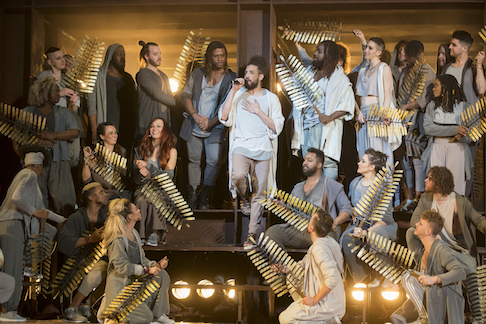
The second part of the musical begins with an imaginative and cleverly staged scene depicting the atmosphere of the Last Supper. As a choral response to the gravity of Christ’s position, the staging of the Apostles singing repeatedly “Look at all my trials and tribulations” speaks to the well-meaning yet uncomprehending naiveté of their thoughts for the future. Tensions between Christ and Judas lead to emotional accusations and the preparations for betrayal in Gethsemane. Interspersed in their dialogue is the unchanged refrain from the Apostles, until the choral repetition becomes comic, yet also sad. A return to the seriousness of this Christ’s mission and sacrifice is signaled by Saunders’ powerful recitation of “I only want to say” in Gethsemane. Even here the humanness of the protagonist emerges in the final line, “Take me now - before I change my mind.” After the capture, the trial before Pilate and thirty-nine lashes are staged with glittering effect, just as the theatrical bombast of Herod’s song - performed with true flair by Mr. Fleming - fits into the hyperbole of the second part of the musical. The final scenes and chorus singing the title song remind the audience of the ultimate origins of Jesus Christ Superstar in music. This stage representation of the music and text emerges as one, and indeed a very strong, possibility.
Salvatore Calomino
image=http://www.operatoday.com/Heath%20Saunders_JESUS%20CHRIST%20SUPERSTAR_LYR180426_392_c.Todd%20Rosenberg.png
image_description=Heath Saunders [Photo © Todd Rosenberg]
product=yes
product_title=Jesus Christ Superstar at Lyric Opera of Chicago
product_by=A review by Salvatore Calomino
product_id=Above: Heath Saunders [Photo © Todd Rosenberg]
May 1, 2018
Persephone glows with life in Seattle
The very oddity of that list makes it clear why Rubenstein’s heritage is so ill-defined almost 60 years after her death. Everybody knows Boléro (though some blanch at the idea of ever hearing it again); but hardly anybody knows the other vehicles Rubenstein’s commissioning cash created to judge if they’re evidence of anything beyond the dancing diseuse’s Promethean vanity.
Such is Stravinsky’s prestige in our time that had he set Perséphone for two actors, one dancer, and seven musical instruments as he did The Soldier’s Tale, we might know it at least as well as we do that towering masterpiece. But thanks to all that money, he wrote it for a stageful of performers (including an obbligato boy’s choir) and the largest orchestra he ever employed after The Rite of Spring.
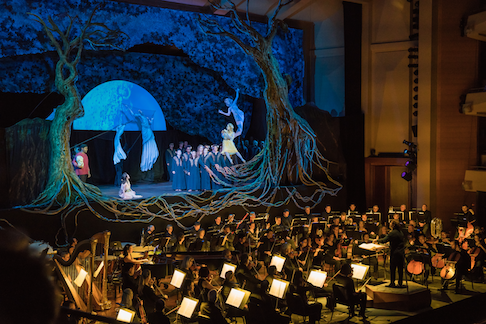 Full stage
Full stage
In consequence, Perséphone has ended up on the shelf of pieces that intrigue serious musicians while putting orchestra managers and marketing directors to panicked flight. Performances without star names attached (Balanchine in 1982 New York, Peter Sellers in 2012 Madrid, Thomas Adès and Kirsten Scott-Thomas in 2018 London) have been few indeed.
The more praise to the Oregon and Seattle Symphony Orchestras to take up puppeteer Michael Curry’s visionary proposal for a full staging of the work, and providing the immense resources to do it justice (though Curry’s credits working with puppet-queen Julie Taymor on Disney’s Broadway Lion King, not to mention the Metropolitan Opera and Cirque du Soleil, probably helped a good deal in putting the deal across.)
The depth and seriousness of the staging seen at Benaroya Hall on April 26 goes far beyond the visible. In narrator role of Eumolpus we had Kenneth Tarver, la clarion voiced tenor who starred at Paris’ Opéra Comique in the title role in Auber’s Fra Diavolo. As Perséphone herself (doubled and tripled, by a dancer and a marionette) we had French actress Pauline Cheviller, reprising a role she played in the 2012 revival of Peter Sellars’ Madrid staging, with tenor Paul Groves as her Eumolpus).
With all this going for it, the SSO’s mounting fell well short of perfection. Part of the problem was the evening’s overall program.
It began with a three-minute version of the Song of the Volga Boatmen: Stravinsky arrangement or not, it seemed as out of place as his Circus Polka, commissioned by the Ringling Brothers to accompany their elephant act.
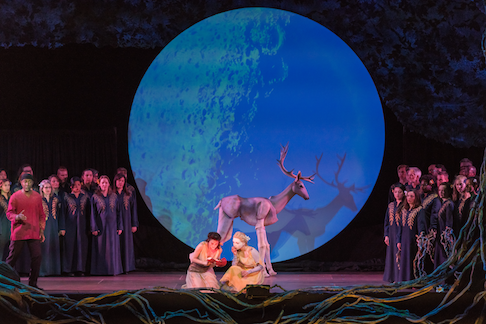 Two Persephones
Two Persephones
The concerto for piano and winds which followed was brilliantly played by virtuoso Marc-André Hamelin (raggedly accompanied by a clearly underrehearsed band of gallantly willing wind players). As if to emphasize the extravagance of the evening, the first half of the evening ended with the delirious hammering of four grand pianos and 10 wildly chanting Russian voices (the Pokrovsky Ensemble, in fine rowdy form) in the 1923 ballet version of the cantata variously known as Svad’ba/Les noces/The Wedding). Too much, very too much, with Hamelin on first piano, a human cherry on the whole towering sundae.
One inadvertent downside of the musical buffet was that throughout the long first half, we had to look at Mr. Curry’s stage-frame for Perséphone (Being a dedicated concert hall, the Mark Taper auditorium has no wing or fly space for scenery storage).
The longer looked at, the less appropriate it began to seem as a reflection of the work to come. André Gide’s libretto portrays a stylized flowery landscape of spring from which the daughter of the earth goddess Demeter is drawn by pity for the dead to the chilly halls of Hell.
In this staging, hell was already more than halfway here. Instead of the meadow flowers of spring, “caressed by a vagabond breeze,” we’ve been looking for more than an hour at the tangled roots of two leafless trees, their gnarled trunks forming a dark oval in which now rises a pale and chilly moon.
The sun never does rise on this world; and as for flowers, what we get when they do appear are giant, lurid fleurs du mal. Mr. Curry’s marionettes are never less than striking: wispy sheets of ghosts, a crippled deer, the puppet Persephone, eerily human and inert at the same time. But with a large human chorus competing for space with them, they don’t have a lot of scope for action. (At one point, puppet-Persephone seems to be trying to escape the frame and into the reed section of the orchestra .)
Mme. Cheviller is a striking figure as Persephone, statuesque without stiffness, moving with grace. Her unamplified voice reached (barely) to the back of the last balcony, and, thanks to the terse supertitles adapted from poet J.D. McClatchy’s translation, a good deal of Gide’s watery sunshine/moonshine verse comes through despite the general dimness of the visual imagery.
The true magic in this performance, for me at least, was the revelation that Perséphone is not just an awkward experiment, an interesting but anomalous novelty in the career of the man who seems more and more “the composer of the 20th century.” The score is surely the least spiky, glittery original music Stravinsky ever wrote: in his oeuvre the only comparable work is his posthumous collaboration with Tschaikovsky on The Fairy’s Kiss (another Rubenstein commission). Instead it recalls the most abstract, most evanescent works of Debussy: the piano preludes, the veiled subtle sounds of his tennis-court ballet Jeux.
It’s curious coincidence that this season in Seattle, we have seen two daring head-on encounters with works on the fringes of the musical repertory: Berlioz’s opéra comique Béatrice et Bénédict at Seattle Opera and now Perséphone at the Seattle Symphony. Neithe rof them a complete success artistically (though both well-received by the city’s increasingly sophisticated audience), both illuminated the works in question, showing, even when falling short of solving the indubitable problems they present, suggestions of how they might be solved by other equally dedicated artists in future.
For Perséphone, I credit above all the playing of the Seattle Symphony musicians under their conductor of eight years Ludovic Morlot. Working together year after year on repertory reflecting Morlot’s Gallic training and tastes, he has polished his orchestra into an exemplary ensemble, with a sound distinctly its own: not French in sonority, but in clarity, taste . . . ésprit.
I have listened to Perséphone off and on for decades, always performed by first-rate forces; but always too always with conscious effort and little pleasure.
Now, having seen it as well, supporting and supported by in its dramatic context, I feel I have at last captured been touched by the spirit of the work: and despite my strictures of the production, I owe to Mr. Curry and his performers my conviction that, approached on its own terms, may one day stage take the stage proudly on its own.
Roger Downey
Perséphone: mélodrame in three acts to a libretto by André Gide
Cast and production information:
Pauline Cheviller (narrator); Kenneth Tarver (Eumolpus); Lauren McRory (Demeter); marionettes, design, and stage direction: Michael Curry; the Northwest Boychoir, Joseph Crnko, director; Seattle Symphony Orchestra and Chorus: Ludovic Morlot, conductor
image=http://www.operatoday.com/bpatoc_sso_persephone_press_preview_0016.png image_description=A scene from Perséphone: mélodrame [Photo © Brandon Patoc] product=yes product_title=Persephone glows with life in Seattle product_by=A review by Roger Downey product_id=A scene from Perséphone: mélodramePhotos © Brandon Patoc
